SEO
200+ Terms & Definitions You Need to Know

Search engine optimization, like any specialized industry, has its own unique set of terminology, definitions, and abbreviations.
This SEO glossary compiles more than 200 of the most common terms you are likely to hear and will definitely need to know during your SEO career.
A | B | C | D | E | F | G | H | I | J | K | L | M | N | O | P | Q | R | S | T | U | V | W | X | Y
A
Above the Fold
Content that appears on a website before the user scrolls. Google created the Page Layout Algorithm in 2012 to lower the rankings of websites featuring too many ads in this space.
AJAX
Asynchronous JavaScript and XML is a type of programming that allows a webpage to send and receive information from a server to change that page dynamically without reloading.
Algorithm
A complex computer program used by search engines to retrieve data and deliver results for a query. Search engines use a combination of algorithms to deliver ranked webpages via a results page based on a number of ranking factors and signals.
Algorithm Change
Some algorithmic changes go completely unnoticed. However, the impact of a major algorithmic change can usually be seen quite quickly, though the change sometimes takes a few weeks to completely roll out. Algorithmic changes come in three forms:
- Algorithm Update: The search engine changes certain signals of an existing algorithm.
- Algorithm Refresh: The search engine re-runs an existing algorithm using the exact same signals as last time.
- New Algorithm: The search engine adds a new algorithm to improve search quality. For example: Google Panda, Google Penguin.
Alt Attribute
HTML code that provides information used by search engines and screen readers (for blind and visually-impaired people) to understand the contents of an image.
Also known as: Alt Text
AMP
Accelerated Mobile Pages (AMP) is an open-source HTML framework that allows a desktop-first page to be delivered faster on mobile. It was used as a criterion to gain visibility in the news Top Stories carousel.
The AMP logo has since been removed from search results and Google announced that AMP is no longer a requirement for appearing in Top Stories. The emphasis is now on Core Web Vitals to measure faster delivery and page loading and the influence of AMP is now questionable.
Analytics
The science of collecting, analyzing, and interpreting data to take future action based on what has (or hasn’t) worked historically.
Also see: Google Analytics
Anchor Text
The clickable word or words of a link. This text is intended to provide contextual information to people and search engines about what the webpage or website being linked to is about. For instance, if you were creating a link to send your visitors to Search Engine Journal, “Search Engine Journal” is the anchor text.
Artificial Intelligence (AI)
The science of making computers perform tasks that require human intelligence. Rather than following a set of programmed rules (like an algorithm), an AI computer system is basically a digital brain that learns. AI can also make and carry out decisions without human intervention.
Authority
The combination of signals search engines use to assess websites and webpages for the purposes of ranking.
Author Authority
Authority is a concept of using the reputation and credentials of a person who writes content online as a ranking factor. Originally, Google tested this in combination with Google+ but despite several patents filed, no evidence supports author authority as a ranking factor.
Google is placing emphasis on E-A-T to reduce disinformation online, especially in YMYL niches such as health and finance. In these spaces, building the authority of an author is recommended for a brand to show credibility, even if it currently doesn’t influence ranking.
B
B2B
Short for business-to-business. In B2B SEO, the buying cycle is longer, products and services are more expensive, and the audience is professional decision-makers.
B2C
Short for business-to-consumer. In B2C SEO, the buying cycle is typically shorter (though it still varies by industry), products and services are (mostly) cheaper, and consumers are the audience.
Backlink
See: Inbound Link
Baidu
The most popular search engine in China, Baidu was founded in January 2000 by Robin Li and Eric Xu.
Bing
The name of Microsoft’s search engine. Bing launched in June 2009, replacing Microsoft Live Search (previously MSN Search and Windows Live Search). Since 2010, Bing has powered Yahoo’s organic search results as part of a search deal Microsoft and Yahoo struck in July 2009.
Black Box
A complex computer program that is poorly understood. Inputs and outputs can be observed, but there is no access to the process itself due to its confidential nature. For example, Google’s algorithm is a black box.
Black Hat
Risky tactics that go against Google’s Webmaster Guidelines.
Also see: Webspam
Blog
A publication of content, sorted in chronological order, with the most recent content appearing at the top. The content reflects personal or corporate interests, and can be written by an individual or a group of contributors. Blogs were originally called web logs or weblogs. However, as “web log can also mean a server’s log files, the term was confusing. To avoid this confusion, the abbreviation “blog was coined, and became the common term.
Bounce Rate
The percentage of website visitors who leave without visiting another page on that website. Bounce rates range widely depending on industry and niche. Although bounce rate can indicate potential content or website issues, it is not a direct ranking factor, according to Google.
Bot
See: Crawler, Googlebot
Branded Keyword
When a user’s query includes an exact match, or variation, of a specific company or brand name. For instance, “Search Engine Journal”, “SEJ”, “SearchEnginejournal.com”, and “Search Engine Journal SEO 101 Guide” are a few examples of branded keywords.
Breadcrumb
A navigational element that helps users easily figure out where they are within a website.
See: Website Navigation
Broken Link
A link that leads to a 404 not found. Typically, a link becomes broken when:
- A website goes offline.
- A webpage is removed without implementing a redirect.
- The destination URL is changed without implementing a redirect.
C
Cache
A technology that temporarily stores web content, such as images, to reduce future page loading times.
Cached Page
A snapshot of a webpage as it appeared when a search engine last crawled it.
Canonical URL
An HTML code element that specifies a preferred website URL, when multiple URLs have the same or similar content, to reduce duplicate content. Also known as canonicalization.
ccTLD
A country-code top-level domain. For instance, a company based in the United Kingdom would have a domain like this: www.example.co.uk, where uk is the ccTLD.
Citation
In Local SEO, a citation is any mention online of a brand Name, Address or Phone number (NAP). Citations are usually found in directories, social network and community profiles, website resources lists, or any mention of a brand online that does not include a link to the website. NAPs can influence ranking and visibility on Google maps.
Click Bait
Content that is designed to entice people to click, typically by overpromising or being intentionally misleading in headlines, so publishers can earn advertising revenue.
Click Depth
Click depth is the number of clicks it takes to get from the home page, or an entrance page, to a destination page on a website. The more clicks it takes, the less likely Google will crawl the page or it will rank.
Pages that are the closest to the homepage are considered to be the most authoritative and the most likely to be crawled and indexed by Google.
Click depth is important for pages to be crawled efficiently and for the flow of link equity; therefore does influence ranking indirectly.
Click-Through Rate (CTR)
The rate (expressed in a percentage) at which users click on an organic search result. This is calculated by dividing the total number of organic clicks by the total number of impressions then multiplying by 100.
Cloaking
Showing different content or URLs to people and search engines. A violation of Google’s Webmaster Guidelines.
CMS
Stands for Content Management System. A web-based application that lets people create, upload, and manage digital assets.
Co-Citation
How frequently two websites (or webpages) are mentioned together by a third-party website, even if those first two items don’t link to (or reference) each other. This is a way search engines can establish subject similarity.
For instance, imagine Search Engine Journal and Search Engine Roundtable never linked to or mentioned each other. However, other websites and blogs would likely mention both SEJ and SER on lists of popular search engine news publications.
To see this in action, see: related:https://www.searchenginejournal.com/ search engine journal
Code To Text Ratio
The amount of text displayed on a page compared to the amount of code used to construct the page is called the code to text ratio. A higher ratio of text to code is considered to provide a better user experience but is not a direct ranking factor.
Poorly written comments, often off-topic and self-promotional, posted by spambots in the hopes of getting a free (but ultimately worthless) link.
Competition
There are two types of competition:
- Direct Competitors: Companies that sell similar products and/or services, serve the same needs, and target a similar audience both online and offline.
- SEO Competitors: Companies that vie for the same keywords and organic search visibility, but with unalike products or services that address different needs and/or target audiences.
Recommended reading:
Content
- Words, images, videos, or sounds (or any combination thereof) that convey information that is meant to be distributed to and consumed by an audience.
- One of the two most important Google ranking factors (along with links). Search engines want to reward content that is useful, informative, valuable, credible, unique, and engaging with better traffic and visibility.
Content is King”
A phrase often used by speakers at conferences and writers on popular SEO (and digital marketing) publications. In this context, “content is king” usually means that content is essential for you to have any SEO, digital marketing, or business success.
This phrase actually dates back to a Bill Gates essay, “Content is King”, published January 3, 1996.
Recommended reading:
Conversion
When a user completes a desired action on a website. Examples of conversions include:
- Completing a purchase.
- Adding items to a shopping cart.
- Completing a form (e.g., requesting a demo, registering for a webinar/event).
- Downloading premium content (e.g., ebook, whitepaper).
- Subscribing to an email newsletter.
- Video views.
Conversion Rate
The rate (expressed in a percentage) at which website users complete a desired action. This is calculated by dividing the total number of conversions by traffic, then multiplying by 100.
Conversion Rate Optimization (CRO)
The process of improving the number or quality of conversions that occur on a website. Some popular CRO tactics include testing changes to website design, copy, images, price, call-to-action, and messaging.
Core Update
When Google makes broad updates to its core algorithm. Google sometimes announces a specific theme to their updates, such as the Page Experience update, but core updates are non-specific and happen several times a year.
Core Web Vitals
A set of metrics that measure the performance of the page related to user experience. Core Web Vitals were introduced alongside the Page Experience update as the main signals that indicate a good user experience:
- Largest Contentful Paint (LCP) – loading performance.
- First Input Delay (FID) – interactivity.
- Cumulative Layout Shift (CLS) – visual stability.
Google did confirm Core Web Vitals as a ranking factor but said that relevance and other factors may be more important.
Correlation
The extent to which a relationship exists between two or more elements. Often used in SEO research to infer relationships of variables on search rankings due to the black box nature of algorithms. Always remember, however, that correlation ≠ causation.
Crawl Budget
The total number of URLs search engines can and want to crawl on a website during a specific time period.
Recommended reading:
Crawl Error
- URLs that a search engine bot is unable to crawl.
- URLs that return a status code error.
Crawler
A program search engines use to crawl the web. Bots visit webpages to collect information and add or update a search engine’s index.
Also known as: Bot, Spider, Web Crawler
Crawling
The process of gathering information, using a crawler, from the billions of public webpages to update, add, and organize webpages in a search engine’s index.
CSS
Cascading Style Sheets describe how HTML elements (e.g., color, fonts) should appear on webpages and adapt when viewed on different devices.
Customer Journey
All of the potential moments (or touchpoints) at which a prospect is exposed to or engages with a brand. All of these interactions are designed to eventually persuade, influence, and convert that prospect to become a customer, client, or subscriber.
Though customer journeys can vary greatly by business type and industry, typically it is made up of four main “stages”:
Awareness > Consideration > Decision > Retention
Google’s Avinash Kaushik offers an alternative framework:
See > Think > Do > Care
Also known as: Buying Process, Consumer Decision Journey, the Customer Journey to Online Purchase, Marketing Funnel, Path to Purchase, Purchase Funnel
D
Data
All the hard numbers that represent real customers – the who, what, where, when, why, and how – all of which is needed to make informed decisions about SEO strategies and tactics.
Dead-End Page
A webpage that links to no other webpages. So called because once a user or bot arrives on this page, there is no place to move forward.
Deep Link
- A link pointing to any webpage other than the homepage.
- A link pointing to content within a mobile app.
Deep Link Ratio
When an internal link points directly to a page other than the homepage on a site, this is known as a deep link. The ratio of deep links compared to links to your homepage is known as deep link ratio.
It is considered that having links directly to deep pages in a site indicates quality of content on the site. The more deep links you have the better the site. There is no evidence to support that deep link ratio has any direct impact on ranking.
De-index
When Google removes a website or webpage, either temporarily or permanently, from search results, specifically its search index. Google provides a Remove URLs tool in the Search Console for voluntary cases; however, a website may also be de-indexed as punishment for violating Google’s Webmaster Guidelines, in the form of a manual action.
Also known as: Delisting
Direct Traffic
In Google Analytics, users that navigate directly to the site by typing the URL directly into the browser or by clicking on a bookmark are known as direct traffic. Google will also include into direct traffic any traffic sources it doesn’t recognize.
Directory
A list of websites, usually separated by related categories and maintained by human editors. Depending on the directory, inclusion could be free or paid. In the past, links from directories were highly sought after (e.g., DMOZ), leading to widespread abuse and overall devaluing of this sort of link building.
Also known as: Web Directory, Link Directory
Disavow
If your link profile includes a high number of spammy, artificial, or low-quality inbound links that may be harming your rankings – and don’t have the ability to get them removed for a legitimate reason (e.g., the link exists on a site you have no control over) – you can use Google’s Disavow Tool tool to tell Google to ignore those links.
DMOZ
The Open Directory Project. This human-edited directory of websites launched June 5, 1998 and closed March 17, 2017.
Do-follow
A link that doesn’t use the “nofollow” attribute. In other words, a link.
Domain
A website address – typically ending in an extension like .com, .org, or .net. For example: www.searchenginejournal.com is the domain of this website.
Domain Age
The date a domain was registered on, to the current date is known as domain age. For example, Search Engine Journal was registered on 10th June 2003, so it has a significant domain age.
It was once considered that a greater domain age gave a domain more authority, but this idea of domain age as an influence on ranking has since been dismissed.
Domain Authority
- The overall “strength” of a website, built up over time, which can help a new page rank well quickly, even before that content has earned links or engagement.
- A score, between 0-100, SEO software company Moz uses to predict the ability of a website to rank in search results.
Recommended reading:
Domain History
Any activity, including backlinks and website built on a domain previously is known as domain history.
If a previous website on a domain received a penalty this will remain attached to the domain and cause issues for the new owner.
It’s recommended to always check the domain history before you purchase a domain.
Doorway Page
Webpages that are created to rank in search engines for specific keywords only for the purpose of redirecting users who click on that page to a different website.
DuckDuckGo
A search engine that was founded September 28, 2008. It is often praised for its heavy focus on user privacy and a lack of filter bubbles (search personalization). DuckDuckGo relies on more than 400 sources to serve its search results, including vertical search engines, its own crawler, DuckDuckBot, Bing, and Yandex. In 2016, 4 billion searches were conducted on DuckDuckGo.
Duplicate Content
When a significant amount of content contained on one webpage matches, or is incredibly similar to, content that exists elsewhere on the same website or a completely different website.
Dwell Time
The amount of time that elapses between when a user clicks on a search result and then returns to the SERP from a website. Short dwell time (e.g., less than 5 seconds) can be an indicator of low-quality content to search engines.
E
E-A-T
Expertise, Authoritativeness, and Trustworthiness was a concept taken from the Google Search Quality Evaluator Guidelines and became known as E-A-T.
E-A-T represents signals that Google uses to determine quality content but it is not a direct ranking factor.
Google has committed to stopping the spread of disinformation, especially from any sites operating in Your Money Your Life (YMYL) niches such as finance or health.
E-commerce
The buying and selling of products, all conducted online.
Recommended reading:
Editorial Link
A link that is given by one website to another without the recipient asking or paying for it.
Also known as: Natural Link.
.edu Links
Educational-focused institutions have a top-level domain (TLD) of .edu. For example, stanford.edu. A link from such a site is known as a .edu link.
Links from .edu sites were considered ‘hard to get’ and thought to have more value for link building. As a result, link builders targeted .edu links until many of the lesser-known .edu sites became devalued by Google and any benefit of the link was ignored.
Engagement Metrics
Methods to measure how users are interact with webpages and content. Examples of engagement metrics include:
- Click-through rate
- Conversion rate
- Bounce rate
- Time on page/site
- New vs. returning visitors
- Frequency and recency
- Dwell time
Entities
People, places, organizations, websites, events, groups, facts, and other things.
Also see: Knowledge Graph
External Link
See: Outbound Link
F
Featured Snippet
For certain queries, usually questions (i.e., who/what/where/when/why/how), Google sometimes shows a special block above the organic search results. This box contains a summary (in the form of paragraph, list, table, or video), as well as the publication date, page title, link to the webpage from which the answer originated, and URL.
Also known as: Position Zero.
Recommended reading:
Findability
How easily the content on a website can be discovered, both internally (by users) and externally (by search engines).
First Link Priority
A concept in internal linking is that Google treats links differently if there are two links on a web page pointing to the same page. It was thought Google would consider the anchor text from the first link to have more influence.
There is no definitive evidence for how Google treats the same link on a page. When adding links to a page, it’s recommended to do this on a user-first basis and apply the link to anchor text where it is relevant.
Links that appear in the bottom section (or “footer) of a website.
See: Website Navigation
Freshness
Freshness refers to the age of content published online.
It is considered that Google gives pBlan-kriority to fresh content in some niches for some queries depending on certain factors. For example, searches related to COVID announcements or sports results.
Query Deserves Freshness (QDF) is part of the Google algorithm that determines when a query should show up-to-date information, especially in breaking news, recurring events, information queries, and product queries.
G
The search engine founded by Larry Page and Sergey Brin in September 1998. Google marked a radical departure from human-edited web directories, relying on web crawling technology and a complex algorithm to analyze hyperlinking patterns to rank websites. Google is the most-used search engine in nearly every country in the world.
Google Analytics
A free web analytics program that can be used to track audience behavior, traffic acquisition sources, content performance, and much more.
Visit: Google Analytics
Google Bomb
A practice intended to make a website rank number one for a surprising or controversial search phrase. This was accomplished by having a large number of websites link to a certain webpage with specific anchor text to help it rank for that term.
For example, in 2003 President George W. Bush’s White House bio ranked number one on a search for “miserable failure.”
Googlebot
The web crawling system Google uses to find and add new websites and webpages to its index.
Google Dance
A term used starting in 2002 for the volatile period of time during which Google updated its search index, roughly every month.
Google Hummingbird
A Google search algorithm that was officially announced in September 2013 after it had been in use for a month. The purpose of Hummingbird was to better understand the full context of queries (i.e., semantic search), rather than certain keywords, in order to provide better results.
Recommended reading:
Google Panda Algorithm
A major Google algorithm update that initially rolled out in February 2011, it was followed by numerous subsequent updates. The goal of Google Panda was to reduce the visibility of low-value content, often produced by “content farms. In 2016, Panda became part of Google’s core ranking algorithm.
Recommended reading:
Google Penguin Algorithm
A major Google algorithm that launched in April 2012, it was followed by a series of updates and refreshes. The goal of Penguin was to reduce the visibility of overly-optimized sites, or sites that excessively abused certain spammy tactics (e.g., building low-quality links, keyword stuffing). In 2016, Penguin started running in real-time as a part of Google’s core algorithm.
Recommended reading:
Google Pigeon Update
The name (given by the SEO industry, not Google) of a significant Google local search update launched July 24, 2014. The goal of Pigeon was to improve the accuracy and relevance of local searches by leveraging more traditional Google ranking signals and improving distance and locating ranking parameters.
Recommended reading:
Google RankBrain
A major Google algorithm change officially introduced in October 2015, although it had been in testing for months before this. With RankBrain, Google added machine learning to its algorithm and has been called the third most important ranking signal. In June 2016, it was revealed that RankBrain has been involved in every query and has an impact on rankings.
Recommended reading:
Google Sandbox
A theorized and debated (but never confirmed by Google) “waiting period” that prevents new websites from seeing the full benefit of their optimization efforts. Typically, this effect is witnessed most often with new sites targeting competitive keywords and can only be overcome when the site gains enough authority.
Google Search Console
Google’s Search Console offers several helpful features, including the ability to monitor sites for indexing errors and site speed. These pages are also used to communicate manual action notifications.
Recommended reading:
Google Search Quality Rater Guidelines
Google uses a document of guidelines for its internal Quality Raters to reference when manually reviewing websites.
The original internal document was confidential and then Google publicly released the Search Quality Rater Guidelines online which is updated from time to time.
Information in the document is a guide to creating quality content and features the concept of E-A-T. The guidelines are not a list of any direct ranking factors.
Google Trends
A website where you can explore data visualizations on the latest search trends, stories, and topics.
Visit: Google Trends
Recommended reading:
Google Webmaster Guidelines
Google’s guidance on good website optimization practices, as well as “illicit” practices that can result in manual action. Simply:
- Make unique, valuable, and engaging websites and webpages for users, not search engines.
- Avoid tricks and techniques that deceive users and are intended only to improve search rankings.
Recommended reading:
.gov Links
Government organizations have a top-level domain (TLD) of .gov. For example, usa.gov. A link from such a site is known as a .gov link.
Only government entities in the US can apply and gain a .gov TLD. Other countries have their own country-specific version, such as .gov.uk.
Government TLD domains are tightly regulated and trusted sources of information. For this reason, a link from a .gov domain is considered to have significant value and has been targeted by link spam.
Gray Hat
A supposed “gray” area between techniques that adhere to Google’s Webmaster Guidelines, but then add an element that bends the rules a little.
Guest Blogging
A popular link building tactic that involves developing content for other websites in exchange for a backlink pointing at your own pages.
Also known as: Guest Posting.
H
Heading
HTML heading tags (H1-H6) separate content into sections, based on importance, with H1 being the most important and H6 being the least important. Headline tags should be used naturally and should incorporate your target keywords where relevant, as doing so may provide a small SEO benefit.
Headline
An H1 tag.
Head Term
A popular keyword with high search volume that is usually difficult to rank for.
Also known as: Head Keyword, Short-Tail
Hidden Text
Any text that can’t be seen by a user that is intended to manipulate search rankings by loading webpages with content-rich keywords and copy. This technique is against Google’s Webmaster Guidelines and can result in a manual action. For example, adding text that is:
- Too small to read.
- The same color as the background.
- Using CSS to push the text off-screen.
Hilltop Algorithm
Influenced by the HITS Algorithm, and added to Google’s algorithm in 2003, Hilltop assigned “expert” status to certain websites or webpages published about a specific topic that also link to unaffiliated pages about that topic.
Recommended reading:
- Hilltop: A Search Engine based on Expert Documents (Krishna Bharat & George Mihaila)
HITS Algorithm
Hyperlink-Induced Topic Search is a link analysis algorithm that assesses a value not just based on content and inbound links (authorities), but also its outbound links (hubs).
Recommended reading:
Homepage
The default, or introductory webpage, of a website.
.htaccess File
A server configuration file that can be used to rewrite and redirect URLs.
HTML
Stands for Hypertext Markup Language. HTML tags are specific code elements that can be used to improve the effectiveness of SEO for webpages and websites.
HTTP
The Hypertext Transfer Protocol is how data is transferred from a computer server to a web browser.
HTTPS
Hypertext Transfer Protocol Secure uses a Secure Sockets Layer (SSL) to encrypt data transferred between a website and web browser. HTTPS is a minor Google ranking factor.
Hub Page
An authoritative central resource (e.g., page or article), dedicated to a specific topic (keyword), that is continually updated and linked to, and also links out to topically-relevant webpages.
I
Inbound Link
A link to a webpage that originates from an external website. For example, if Search Engine Journal were to link to Google, that would count as an inbound link on Google’s side; if Google were to link to Search Engine Journal, that would be an inbound link on SEJ’s side.
Index
The database search engines use to store and retrieve information gathered during the crawling process.
Indexability
How easily a search engine bot can understand and add a webpage to its index.
Indexed Page
A webpage that has been discovered by a crawler, has been added to a search engine index, and is eligible to appear in search results for relevant queries.
Information Architecture
How a website is organized and where various content and navigational elements are located on webpages.
Information Retrieval
The process of searching for information (e.g., text, images, video) from a large database and then presenting the most relevant information to an end user.
Internal Link
See: Website Navigation
IP Address
An Internet Protocol Address. IP addresses can be:
- Shared: Numerous websites share an address within one server or a group of servers (a.k.a., virtual hosting).
- Dedicated: A website has its own address.
Neither will help you rank better; however, a dedicated IP address can increase site speed.
J
JavaScript (JS)
A programming language that makes it possible to dynamically insert content, links, meta data, or other elements, on websites. JavaScript can potentially make it difficult for search engine bots to crawl and index webpages and increase the time it takes for webpage to load for users.
K
Keyword
The word, words, or phrase that an SEO professional or marketer targets for the purpose of matching and ranking for what users are searching for. The words used on webpages can help search engines determine which pages are the most relevant to show in organic results when a searcher enters a query. Keywords usually represent topics, ideas, or questions.
Also known as: Keyphrase.
Keyword Cannibalization
A type of self-competition that occurs when multiple pages from one website rank for the same query on a SERP. This can result in a lower CTR, diminished authority, and lower conversion rates than from having one consolidated webpage that ranks well.
Recommended reading:
Keyword Density
How often a word or phrase appears within the content of a webpage. At best, this unproven concept is outdated, if ever really mattered to search engines. There is no ideal percentage that will help a webpage rank better.
Keyword Research
The process of discovering any relevant topics, subjects, and terms searchers enter into search engines, as well as the volume and competition level of those terms. This practice is made possible by a variety of free and paid tools.
Keyword Prominence
When a keyword is placed as high as possible on a web page to influence ranking for a search term.
Using a keyword inserted at the beginning of a page, for example in the first paragraph, does send a strong signal to Google about the page.
Keyword prominence does work as a ranking signal if the theme of the page is aligned with the keyword.
Keyword Stemming
In language and grammar, words are constructed around a variation upon a root or stem. For example, shopping, shopped, shops are all variations of the stem ‘shop’.
When trying to rank for a term such as ‘shop’, using variations of the word on the page (shopping, shopped) will all be considered the same stem keyword by Google. This also applies to plurals such as bikes/bikes or fly/flies.
Keyword stemming is Google’s ability to understand the variations of a keyword and is part of its algorithm.
Keyword Stuffing
Adding irrelevant keywords, or repeating keywords beyond what is natural, to a webpage in the hopes of increasing search rankings. This spam tactic is against Google’s Webmaster Guidelines and can result in a manual action.
Knowledge Graph
An entity database Google uses to surface facts and information on people, places, and things (a.k.a., entities) – and their connections – in a Knowledge Panel or carousel at the top of search results on relevant queries.
Knowledge Panel
A box that appears at the top of, or on the right rail (desktop only), of Page 1 of Google’s search results for relevant queries. This panel contains facts and information on people, places, and things, as well as links to related websites or Google searches.
KPI
Stands for key performance indicator. A measurement method businesses use to gauge whether marketing and business objectives, targets, and goals are being reached.
L
Landing Page
- Any webpage that a visitor can navigate to.
- A standalone webpage that is designed to capture leads or generate conversions.
Latent Semantic Indexing (LSI)
An information retrieval method designed to help search engines identify the correct context of a word. LSI doesn’t play a useful role in SEO today.
See: Google Latent Semantic Indexing
Lead
A person who may or may not be interested in your product(s) and/or service(s). A lead willingly shares their email address (and usually other personal or contact information) in exchange for something they deem of value from the website.
Link
A connection between two websites built using HTML code. A link enables users to navigate to websites, social networks, and apps. Links play a critical role in how search engines evaluate and rank websites.
Also known as: Backlink.
Link Bait
Intentionally provocative content that is meant to grab people’s attention and attract links from other websites.
Link Building
A process designed to get other trusted and relevant websites to link to your website to help improve your organic search rank and visibility. Link building can be done by:
- Conducting outreach to media outlets, bloggers, influencers, and webmasters.
- Attracting editorial links naturally, by publishing various types of high-quality or sensational content.
- Paying for them. For example, you can obtain links via sponsored content, paid reviews, or paying for a specific type of link to appear on another website.
- Forging partnerships.
- Manually. For instance, you link together various properties you manage or own, or add your site to online directories or review sites.
Link Equity
The value of inbound links, in terms of relevance, authority, and trust.
Link Farm
When a group of websites link to each other, usually using automated programs, in the hopes of artificially increasing search rankings. A spam tactic.
Also known as: Link Network, Blog Network, Private Blog Network
Link Juice
A term you should never use in public or online.
Did you mean…: Authority or PageRank
Link Profile
Every type of link that points to a particular website. The quality of a website’s link profile can vary widely, depending on how they were acquired and the anchor text used.
Link Stability
Where a link remains on a page consistently for a period of time without being changed or updated.
Google did apply for a patent that referred to link churn and how often the links on a page were changed, but there is no evidence that link stability has any influence on ranking.
Link Velocity
How quickly (or slowly) a website accumulates links. A sudden increase in link velocity could potentially be a sign of spamming, or could be due to viral marketing or doing something newsworthy (either intentionally or unintentionally).
Links, Internal
Links that navigate from one page to another page on the same domain. Internal links can be inserted on a page, in the main navigation menu, or in the sitemap.
Internal links can be used to indicate the importance of a page on a site. For example, a page that is directly linked from the home page compared to a page that is four clicks from the homepage.
Internal links are important because Googlebot crawlers follow internal links to navigate your site and find new pages.
Links, NoFollow
In a hyperlink, rel=”nofollow” is an attribute added to the link to show that you are not passing any credit or endorsement to the page you are linking to
Nofollow was originally introduced by Google to limit comment spam and devalued all nofollow links, but they have since changed how the directive works.
Nofollow is now considered a ‘hint’ which means they may still use some information about linking patterns, but generally, still accept that no weight should be passed through the link.
Links, Outbound or External
An external or outbound link is a link from a page on x domain page to a page on y domain. For example, a link from searchenginejournal.com/google to google.com/about-us
It was considered that external links to authority sites added value to a page because it demonstrates that the page is well-researched and is using trusted sources.
External links are not considered to have any influence on ranking and should only be used to cite sources where relevant.
Log File
A file that records users’ information, such as IP addresses, type of browser, Internet Service Provider (ISP), date/time stamp, referring/exit pages, and number of clicks.
Log File Analysis
The process of exploring the data contained in a log file to identify trends, administer the site, track user’s movement around the site, gather demographic information, and understand how search bots are crawling the website.
Long-Tail Keyword
- Highly specific multiple-word terms that often demonstrate higher purchase intent.
- Less popular keywords that have low search volume that are usually easier to rank for.
M
Machine Learning
A subset of Artificial Intelligence in which a system uses data to learn and adjust a complex process without human intervention.
Manual Action
Google’s term for a penalty. Google will take manual action on a website after a human reviewer (i.e., a Google employee) manually reviews a website to confirm whether it has failed to comply with Google’s Webmaster guidelines. Penalized websites can either be demoted or removed entirely from search results. Manual actions can be assessed to the entire website or just certain webpages.
Meta Description
A tag that can be added to the “head section of an HTML document. It acts as a description of a webpage’s content. This content isn’t used in ranking algorithms, but is often displayed as the “snippet that appears in the search results. Accurate and engaging descriptions can increase organic click-through rate.
Meta Keywords
A tag that can be added to the “head section of an HTML document. Adding a bunch of keywords here won’t help you rank – search engine algorithms have ignored this tag for ranking purposes for years due to abuse (in the form of keyword stuffing).
Meta Tags
Information that appears in the HTML source code of a webpage to describe its contents to search engines. The title tag and meta description are the most commonly used types of meta tags in SEO.
Metric
A way to measure activity and performance in order to assess the success (or lack thereof) of an SEO initiative.
N
Natural Link
See: Editorial Link
Negative SEO
A rare but malicious practice where webspam techniques are used to harm the search rankings of another website, usually a competitor.
Recommended reading:
Niche
A specific market or area of interest consisting of a small group of highly-passionate people.
Noarchive Tag
A meta tag that tells search engines not to store a cached copy of your page.
Nofollow Attribute
A meta tag that tells search engines not to follow one specific outbound link. This is done in cases when a website doesn’t want to pass authority to another webpage or because it’s a paid link. The nofollow attribute looks like this:
<a href=”http://www.example.com/” rel=”nofollow”>Anchor text goes here</a>
Noindex Tag
A meta tag that tells search engines not to index a specific webpage in its index.
Nosnippet Tag
A meta tag that tells search engines not to show a description with your listing.
“(not provided)”
After search engines moved to secure search in 2011, keyword data was removed from Google Analytics, replaced with “(not provided)” – thus making it impossible to know which queries were responsible for visitors finding a website.
Recommended reading:
O
Off-Page SEO
Demand generation and brand awareness activities that take place outside of a website. In addition to link building, promotion tactics can include social media marketing, content marketing, email marketing, influencer marketing, and even offline marketing channels (e.g., TV, radio, billboards).
On-Page SEO
These activities all take place within a website. In addition to publishing relevant, high-quality content, on-page SEO includes optimizing HTML code (e.g., title tags, meta tags), information architecture, website navigation, and URL structure.
Organic Search
The natural, or unpaid, listings that appear on a SERP. Organic search results, which are analyzed and ranked by algorithms, are designed to give users the most relevant result based on their query.
Orphan Page
Any webpage that is not linked to by any other pages on that website.
Outbound Link
A link that directs visitors to a page on a different website than the one they are currently on.
P
PageRank
According to Google: “PageRank is the measure of the importance of a page based on the incoming links from other pages. In simple terms, each link to a page on your site from another site adds to your site’s PageRank. Not all links are equal.” The algorithm was named after Google co-founder Larry Page.
Recommended reading:
Page Speed
The amount of time it takes for a webpage to completely load. Page speed is ranking factor.
Pageview
A webpage is loaded in a browser.
Paid Search
Pay-per-click advertisements that appear above (and often below) the organic results on search engines.
PBN
Stands for Private Blog Network.
See: Link Farm.
Stands for Portable Document Format file. PDFs can contain text, images, links, videos, and other elements.
Recommended reading:
Penalty
See: Manual Action
Persona
A fictionalized representation of an ideal website visitor or customer – their demographics, behavior, needs, motivations, and goals – all based on actual data.
Also known as: Buyer Persona, Marketing Persona
Personalization
When search engines use search history, web browsing history, location, and relationships to create a set of search results tailored to a specific user.
PHP
Hypertext Preprocessor is a scripting language used to create dynamic content on webpages.
Piracy
Search engines aim to reduce the organic search rankings of content that infringes on copyright. Google introduced a filter in 2012 that reduces the visibility of sites reported for numerous DMCA-related takedown requests.
Recommended reading:
Pogo-sticking
When, after entering a query, a searcher bounces back and forth between a SERP and the pages listed in those search results.
Also see: Dwell time
Position
See: Rank
PPC (Pay Per Click)
A type of advertising where advertisers are charged a certain amount (usually determined by bid, relevance, account history, and competition) every time a user clicks on the ad. Combining PPC and SEO can result in more SERP real estate, clicks, and conversions. Also, PPC data can inform your SEO strategy, and the reverse is also true.
Q
QDF
Stands for query deserves freshness, where a search engine might decide to show newer webpages in search results (rather than older pages) if a particular search term is trending, perhaps because a news event has resulted in a surge in searches on that topic.
Recommended reading:
Quality Content
Content that helps you successfully achieve business or marketing goals (e.g., driving organic traffic or social shares, earning top search rankings, generating leads/sales).
Quality Link
An inbound link that originates from an authoritative, relevant, or trusted website.
Query
The word, words, or phrase that a user enters into a search engine.
Also known as: A search.
R
Rank
Where a webpage appears within the organic search results for a specific query.
Ranking Factor
An individual component which contributes to a complex series of algorithms that determine where webpages should appear with the organic search results for a specific query. For years, Google has said that its algorithms “rely on more than 200 unique signals” to help users find the most relevant webpage or answer.
Also known as: Ranking Signal.
Reciprocal Links
When two websites agree to exchange links to one another.
Redirect
A technique that sends a user (or search engine) who requested one webpage to a different (but equally relevant) webpage. There are two types of redirects:
- 301: Permanent
- 302: Temporary
Referrer
URL data that identifies the source of a user’s webpage request.
Reinclusion
The process of asking a search engine to return a website or webpage(s) to its search index after de-indexing.
Relevance
A way search engines measure how closely connected the content of a webpage is aligned to match the context of a search query.
Reputation Management
The practice of crafting a positive online perception of a brand or person – including in search results and on social media – by minimizing the visibility of negative mentions.
Also known as: Online Reputation Management, Public Relations
Responsive Website
A website designed to automatically adapt to a user’s screen size, whether it’s being viewed on a desktop or mobile device.
Rich Snippet
Structured data can be added to the HTML of a website to provide contextual information to the search engines during crawling. This information can then be displayed in the SERPs, resulting in an enhanced listing, known as a rich snippet.
Recommended reading:
robots.txt
The Robots Exclusion Protocol (or Standard) is a text file, accessible at the root of a website, that tells search engine crawlers which areas of a website should be ignored.
Return on Investment (ROI)
A way to measure the performance of SEO activities. This is calculated by dividing how much revenue you earned via organic search by the cost of the total investment, then multiplying by 100.
S
Schema
A form of microdata which, once added to a webpage, creates an enhanced description (commonly known as a rich snippet), which appears in search results.
Scrape
A technique used to copy website content or information using a computer program or script. Search engines, such as Google, scrape data in order to build a searchable index of websites.
Also known as: Web scraping.
Search Engine
A computer program that enables users to enter a query in order to retrieve information (e.g., files, websites, webpages) from that program’s index (i.e., a web search engine, such as Google, indexes websites, webpages, and files found on the World Wide Web). A search index is built and updated using a crawler, with items being analyzed and ranked by a series of algorithms.
Also see: Baidu, Bing, DuckDuckGo, Google, Yahoo, Yandex
Search Engine Marketing (SEM)
An umbrella term for increasing a website’s visibility in search engine results pages, encompassing both paid and organic activities.
Search Engine Optimization (SEO)
The process of optimizing a website – as well as all the content on that website – so it will appear in prominent positions in the organic results of search engines. SEO requires an understanding of how search engines work, what people search for (i.e., keywords and keyphrases), and why people search (intent). Successful SEO makes a site appealing to users and search engines. It is a combination of technical (on-page SEO) and marketing (off-page SEO).
See: On-Page SEO, Off-Page SEO
Search Engine Results Page (SERP)
The page search engines display to users after conducting a search. Typically, search engines show about 10 organic search results, sorted by relevance. Depending on the query, other search features may be shown, including:
- AdWords Ads (above and below the organic search results)
- Featured snippets (a.k.a., Position Zero)
- Images
- Knowledge panels
- Local Pack (with map)
- News
- Related questions
- Related searches
- Shopping results
- Sitelinks
- Tweets
- Videos
Also known as: SERPs, when referring to multiple search engine results pages.
Search History
Search engines track every search users conduct (text and voice), every webpage visited, and every ad clicked on. Search engines may use this data to personalize the results for signed in users.
Also known as: Web Browsing History.
Share of Voice
How many impressions a brand receives in the SERPs for search terms when compared to the total impressions that the brand’s competitors receive for those same search terms.
Sitelinks
Up to six algorithmically-chosen links that appear below the listing for the same website of a top-ranked organic search result. Pages can be blocked from appearing as sitelinks within the Search Console or Bing Webmaster Tools.
Also known as: Deep Links (Bing).
Sitemap
A list of pages on a website. There are two types of sitemaps:
- HTML: This type of sitemap, typically organized by topics, helps site users navigate a website.
- XML: This type of sitemap provides crawlers with a list of webpages on a website.
Sitewide Links
A link that appears on every page of a website, typically in a sidebar or footer of blogs or websites that use templates.
Social Media
Platforms (websites and apps) where users can interact with each other, as well as create, share, and consume content.
Social Signal
Any factors that demonstrate authority and influence on popular social networking websites. For example, the social authority of a user on Twitter.
Although many correlation studies have indicated that socials signals impact rankings (e.g., number of Likes/shares a piece of content receives), Google has publicly stated that social signals are not a direct ranking factor. Popular sites that have a lot of social media engagement tend to rank well for other reasons.
Spam
See: Webspam
Spider
See: Bot
Split Testing
A controlled experiment used to compare at least two webpages to measure the effects of a different variable on conversions. After the pages are shown for a long enough period of time to site visitors to gather an adequate amount of performance data, a “winner” can be declared.
Also known as: A/B Testing.
SSL Certificate
A digital certificate used for website identity authentication and to encrypt information sent to the server using Secure Sockets Layer technology.
Status Codes
The response codes sent by a server whenever a link is clicked, a webpage or file is requested, or a form is submitted. Common HTTP status codes important to SEO:
- 200 (OK)
- 404 (Not Found)
- 410 (Gone)
- 500 (Internal Service Error)
- 503 (Service Unavailable)
Stop Word
A frequently used word. For example: a, at, for, is, of, on, the. Search engines have, in the past, ignored these words to save time/resources when indexing. Search engines have evolved greatly since the early days, and stop words sometimes are meaningful, so this isn’t something to worry much about for SEO purposes.
Recommended reading:
Subdomain
A separate section that exists within a main domain. For example: http://jobs.searchenginejournal.com/ is a subdomain that exists within the main domain of https://www.searchenginejournal.com/
T
Taxonomy
Organizing and categorizing a website to maximize content findability and help users complete desired on-site tasks.
Time on Page
An inexact estimation of how long a user spent looking at a particular webpage. Pages with high exit rates can greatly skew this data.
Title Tag
An HTML meta tag that acts as the title of a webpage. Typically, the title tag is the title search engines use when displaying search listings, so it should include strategic and relevant keywords for that specific page. The title tag should also be written so it makes sense to people and attracts the most clicks. Typically, title tags should be less than 65 characters.
Top-Level Domain (TLD)
The extension of a given web address. These include:
There are also many more industry and country-specific options.
Also known as: gTLD (Generic Top-Level Domain); Domain Extension.
Traffic
The people (and sometimes bots) who visit your website.
Trust
Generally applies to the history of a domain (e.g., whether it cites or features expert sources, builds a positive reputation, adheres to Webmaster Guidelines).
TrustRank
A link analysis technique used to separate good “reputable seed pages” from web spam.
Recommended reading:
U
User-Generated Content (UGC)
Any form of content – videos, blog posts, comments, reviews, etc. – that is created by users or customers.
Universal Search
When search engines pull data from multiple speciality databases to display on the same SERP. Results can include images, videos, news, shopping, and other types of results.
Also known as: Blended Search.
Unnatural Link
Any links Google identifies as suspicious, deceptive, or manipulative. An unnatural link can result in Google taking manual action on your website.
URL
A uniform resource locator is the specific string of characters that lead to a resource on the web. The term URL is usually short-hand for the letter-based web address (e.g., www.searchenginejournal.com) entered into a browser to access a webpage.
URL Parameter
The values added to a URL in order to track where traffic comes from (i.e., which link someone clicked on to discover your website or webpage). Here’s an example of a URL parameter (bolded):
https://www.searchenginejournal.com/example-article-url/999999/?utm_source=share-back-traffic&utm_medium=desktop-share-button&utm_campaign=twitter
Also known as: Query String.
Usability
How easy it is for people to use your website. Site design, browser compatibility, disability enhancements, and other factors all play a role in improving usability and making your site accessible for as many people as possible.
User Agent
Web crawling software.
User Experience (UX)
The overall feeling users are left with after interacting with a brand, its online presence, and its product/services.
V
Vertical Search
A specialized type of search where the focus is only on a specific topic, type of content, or media. For example, YouTube (video), Amazon (shopping), Kayak (travel), Yelp (business reviews).
Virtual Assistant
A bot that uses natural language processing to perform tasks, such as conducting web searches. For instance, Apple’s Siri or Microsoft’s Cortana.
Visibility
The prominence and positions a website occupies within the organic search results.
Voice Search
A type of voice-activated technology that allows users to speak into a device (usually a smartphone) to ask questions or conduct an online search.
W
Webpage
A document that exists on the World Wide Web and can be viewed by web browsers.
Website
A collection of webpages hosted together on the World Wide Web.
Website Navigation
How a website connects its webpages to help visitors navigate that site. Website navigation comes in a few different forms, including:
- Main Navigation: The major topics or subjects your website is focused on. For instance, on SEJ our Main Navigation consists of SEO, News, PPC, Content, and Social.
- Secondary Navigation: Topics related to the main navigation. For instance, on SEJ secondary navigation includes links to webinars, podcasts, guides, SEJ Summit, and other topics.
- Footer Navigation: Typically this includes links to pages that contain important informational resources about a brand or business. These pages usually aren’t important for ranking purposes. For example, SEJ’s footer navigation links to our About Us page, privacy policy, and our various social profiles.
- Related Links: This area usually appears in the right rail or beneath content. It might be called “Most Popular,” “Most Read,” or “Trending Now.”
- Content Links: Links that appear within your main content (e.g., articles, landing pages).
- Breadcrumb Navigation: This type is less popular than it once was. Essentially, each webpage shows a “trail” to help quickly tell visitors where they are on your site. For example: Home > SEO > Link Building > What Is Website Navigation?
Also known as: Internal Links (or Internal Linking), Site Architecture
Webspam
Any methods that exist solely to deceive or manipulate search engine algorithms and/or users.
Also known as: Black Hat SEO, Spam, Spamdexing, Search Spam
White Hat
Tactics that comply with Google’s Webmaster Guidelines.
Word Count
The total number of words that appear within the copy of content. Too little (or thin) content can be a signal of low-quality to search engines.
WordPress
A popular blogging and content management system.
X
XML
Extensible Markup Language is a markup language search engines use to understand website data.
XML Sitemap
A list of all the pages on a website that search engines need to know.
Y
Yahoo
Yahoo was born in April 1994 and was an incredibly popular search engine and portal in the ’90s. Yahoo search was mostly human-powered, at least until June 2000 when a then-unknown search engine called Google began powering Yahoo’s organic search results. That deal continued until 2004, when Yahoo started using its own search technology. Since 2010, Yahoo’s organic search results have been powered by Microsoft’s search engine, Bing.
Yandex
The most popular search engine in Russia, Yandex was founded September 23, 1997 by Arkady Volozh and Ilya Segalovich.
Featured Image: Blan-k/Shutterstock
SEO
25 WordPress Alternatives Best For SEO

WordPress powers hundreds of millions of websites, but it is not the only content management system (CMS) option.
There’s a diverse marketplace of publishing platforms for those seeking alternatives. This review provides an overview of 25 leading alternatives to WordPress across key website categories.
We explore user-friendly website builders like Wix, Squarespace, and Weebly, which offer drag-and-drop simplicity. We look at flexible open-source options for developers and tech-savvy users, including Joomla, Drupal, and Hugo.
Ecommerce merchants can choose between hosted platforms like Shopify or open-source solutions like Magento. We also cover blogging-focused options like Ghost and Tumblr, web hosting providers like Bluehost, and community management tools like vBulletin.
For each alternative, we summarize the key features, benefits, and drawbacks to consider. Factors like budget, technical abilities, and website goals are examined to help identify the best fit based on individual needs.
While WordPress powers a large share of sites, there’s no shortage of quality options for creating the perfect online presence for those seeking alternatives.
Why Consider A WordPress Alternative?
There are several reasons why someone might consider a WordPress alternative for their website:
- Specific needs: While WordPress is versatile, some websites may have particular requirements for which other platforms are better suited.
- Ease of use: Some users may find WordPress challenging, especially if they lack technical skills.
- Maintenance and security: As an open-source platform, WordPress requires users to handle updates, backups, and security measures themselves.
- Built-in features: Some alternatives come with built-in features that WordPress requires plugins for.
- Customization: While WordPress offers many customization options, some users may prefer platforms that allow more granular control over the website’s appearance and functionality.
- Simplicity: Other publishing platforms might be a better fit for users who want a simple platform to publish content without dealing with the complexities of managing a website.
How To Choose An Alternative To WordPress
Choosing the right WordPress alternative depends on your specific needs and goals. To help you make an informed decision, consider the following factors:
- Purpose of your website: Determine its primary purpose. Is it a blog, an online store, a portfolio, or a complex business website?
- Budget: Consider your budget for building and maintaining your website. Some alternatives are free, while others require a subscription or a one-time payment.
- Technical skills: Assess your technical skills and those of your team. Some alternatives are designed for users with little coding experience, while others may require more technical knowledge.
- Customization and flexibility: Evaluate how much control you want over your website’s appearance and functionality.
- Scalability: Consider your website’s potential for growth. If you anticipate a significant increase in traffic or content, choose a platform that can scale with your needs.
- Support and community: Look into the level of support and the size of the community surrounding each alternative.
- Hosting: Decide whether you prefer a self-hosted solution or a hosted platform.
- Features: List the features your website requires. Ensure that your alternative offers these features natively or through extensions.
Once you’ve considered these factors, research various WordPress alternatives and compare them based on your requirements.
Read reviews, explore user communities, and, if possible, test out the platforms through free trials or demos.
This will help you better understand how each alternative works and whether it aligns with your needs and expectations.
25 Best WordPress Alternatives
1. Wix
Wix is best suited for individuals, small businesses, and entrepreneurs who want to create a professional-looking website without extensive technical skills or a large budget.
The platform’s user-friendly drag-and-drop interface makes it easy for users to design and customize their websites, offering various templates and design elements suitable for multiple purposes.
As a hosted platform, Wix takes care of technical aspects like server maintenance and security updates, making it ideal for those who don’t want to deal with these issues.
Wix also offers a free plan, allowing users to create a website without cost, although with limitations such as Wix branding and a non-custom domain.
One nuance to remember when using Wix is that once you’ve chosen a template and started building your site, it can be challenging to switch to a different template without redesigning your content.
Key Features:
- Full hosting solution.
- No software to self-install.
- Drag-and-drop visual builder.
- Extensions are available.
- Optimized for mobile.
- Blog module.
- Ecommerce store.
- Social media tools.
Pros:
- All-in-one website builder and platform.
- Free version available.
- Premade designs and templates.
- Free subdomain available for all plans.
- Free custom domain available with paid plans.
- Customer support.
Cons:
- There is no option to retain complete control of your site as you can with WordPress.
- No access to source code.
2. Squarespace
 Screenshot from: squarespace.com, March 2024.
Screenshot from: squarespace.com, March 2024.Squarespace is best suited for creatives, bloggers, and small business owners who want to create visually stunning websites with minimal technical knowledge.
The platform is known for its sleek, modern templates, which showcase content beautifully and are optimized for mobile devices.
As an all-in-one platform, Squarespace includes hosting, domain registration, and various tools for managing your website.
While Squarespace offers a high degree of customization, it may not be as flexible as some alternatives. The platform has a specific structure and set of features, which can be limiting for those who require advanced functionality or integrations.
Nonetheless, for most users, Squarespace’s built-in features and integrations are more than sufficient.
One tip for getting the most out of Squarespace is to use its built-in SEO and marketing tools, such as custom meta descriptions, alt tags, and automatic sitemaps.
Key Features:
- Complete hosting solution (including video).
- No software to self-install.
- Drag-and-drop visual builder.
- Extensions are available.
- Optimized for mobile.
- Blog module.
- Ecommerce store.
- Social media tools.
Pros:
- All-in-one website builder and platform.
- Free version available.
- Premade designs and templates.
- Free subdomain available for all plans.
- Free custom domain available with an annual subscription.
- Customer support.
Cons:
- There is no option to retain complete control of your site as you can with WordPress.
- No custom coding.
- No access to source code.
- No third-party extensions.
3. Weebly
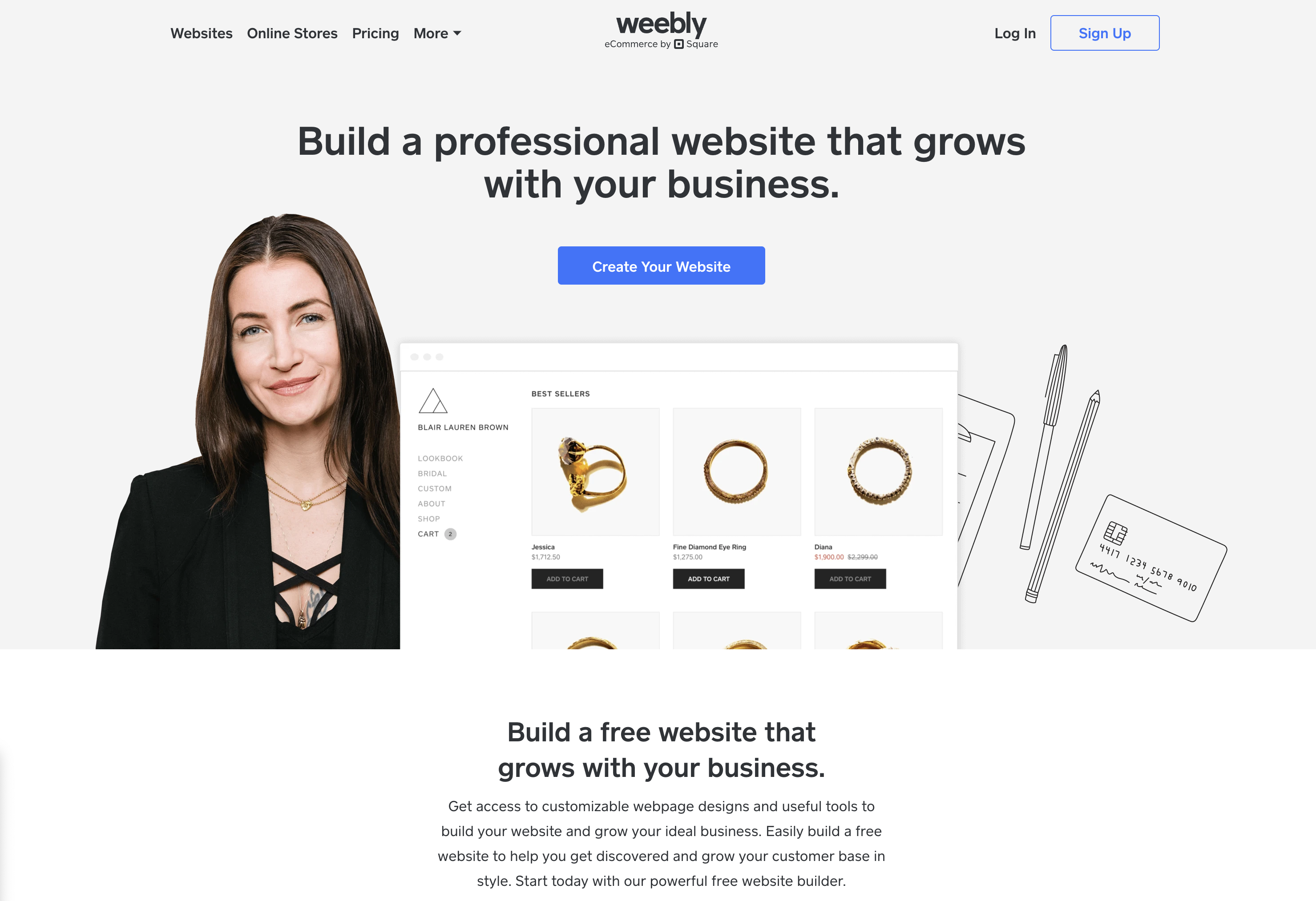 Screenshot from: weebly.com, March 2024.
Screenshot from: weebly.com, March 2024.Weebly is best suited for individuals, small businesses, and entrepreneurs who want to create a simple, functional website without investing much time or money.
The platform’s drag-and-drop interface and intuitive editor make it beginner-friendly and easy to use, even for those without website-building experience.
However, it may not be as powerful or flexible as other alternatives, with a limited set of features and integrations that can be restrictive for those requiring advanced functionality or custom solutions.
One tip for getting the most out of Weebly is to explore its app center, which offers a range of third-party apps and integrations to extend your website’s functionality, including tools for marketing, social media, and ecommerce.
Key Features:
- Full hosting solution.
- No software to self-install.
- Drag-and-drop visual builder.
- Extensions are available.
- Optimized for mobile.
- Blog module.
- Ecommerce store.
- Social media tools.
Pros:
- All-in-one website builder and platform.
- Free version available.
- Premade designs and templates.
- Free subdomain available.
- Inexpensive premium plans are as low as $6.00 per month.
- Free custom domain available with premium plans.
- Customer support.
Cons:
- No option to retain complete control of your site as you can with WordPress.
- No access to source code.
- The free version restricts you to a maximum of five pages.
4. Google Sites
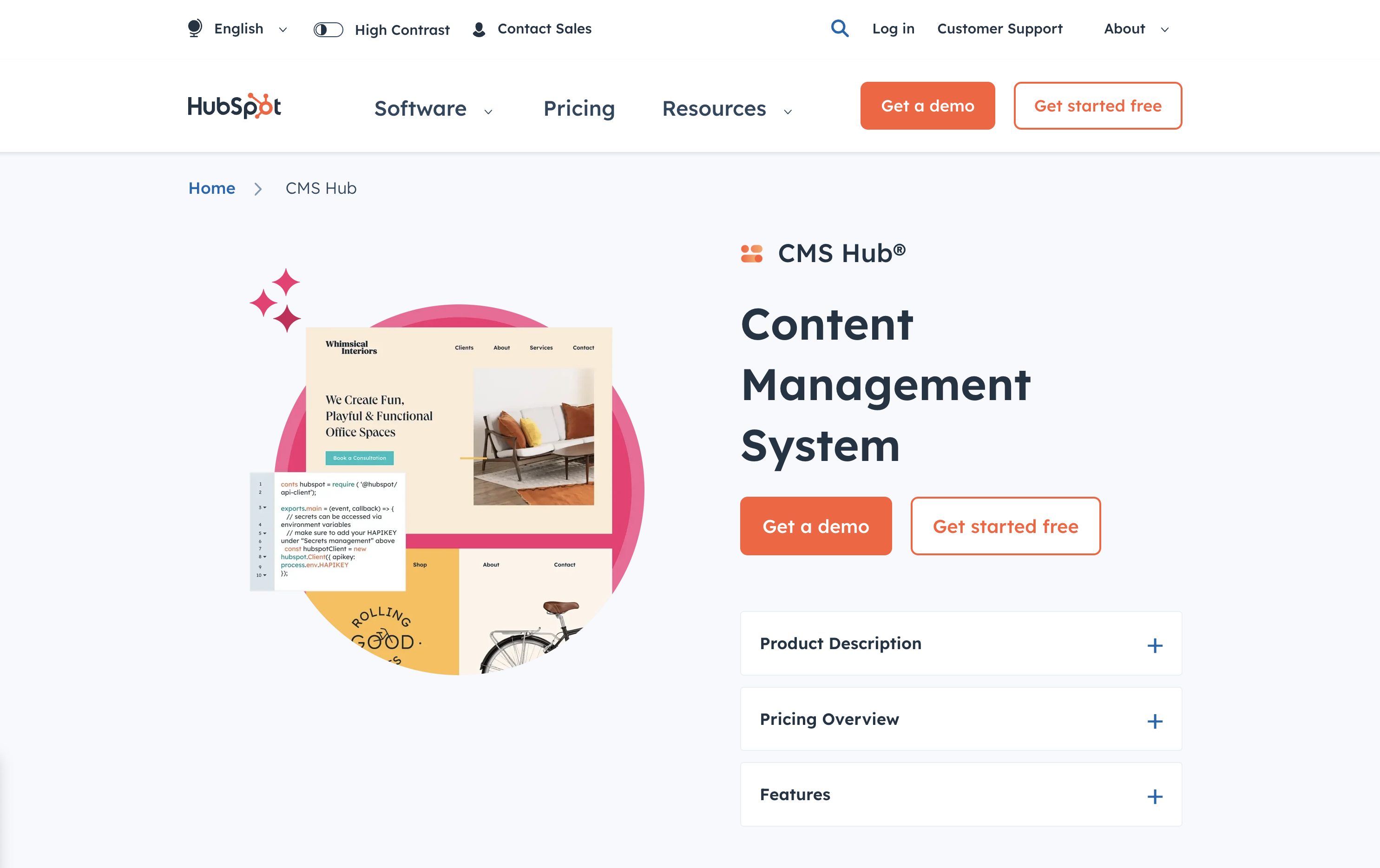 Screenshot from: workspace.google.com/intl/en_ph/lp/sites/, March 2024.
Screenshot from: workspace.google.com/intl/en_ph/lp/sites/, March 2024.Google Sites is best suited for individuals, educators, and small businesses who need a simple, easy-to-use platform for creating basic websites or intranets. Its seamless integration with other Google tools, like Google Docs, Sheets, and Drive, makes it an excellent choice for those familiar with and heavily using these tools.
Google Sites also offers collaboration features, allowing multiple users to work on the same website simultaneously, making it ideal for team projects or class websites.
However, it’s a relatively basic website builder compared to other alternatives, with limited features and customization options. It may not be the best choice for those needing advanced functionality or design flexibility.
Additionally, it lacks built-in ecommerce features, making it less suitable for online stores.
One tip for getting the most out of Google Sites is leveraging its integration with other Google tools, such as embedding Google Docs, Sheets, or Slides into your web pages or using Google Forms to collect visitor data.
Key Features:
- The creator has complete control over page access and permissions.
- Tools can be accessed anywhere.
- It can be used as a basic project management program.
- Plenty of web development and deployment options.
- Real-time editing.
- Uses website speed optimization tools to minimize loading times.
Pros:
- Fast to get started and easy to use.
- Free to use.
- Integrated with other Google products.
Cons:
- Limited functionality compared to other website builders.
- It may not work with non-Google apps.
- Limited customization options.
- No SEO tools, and you can’t edit metadata.
- It cannot integrate Facebook pixels.
5. Jekyll
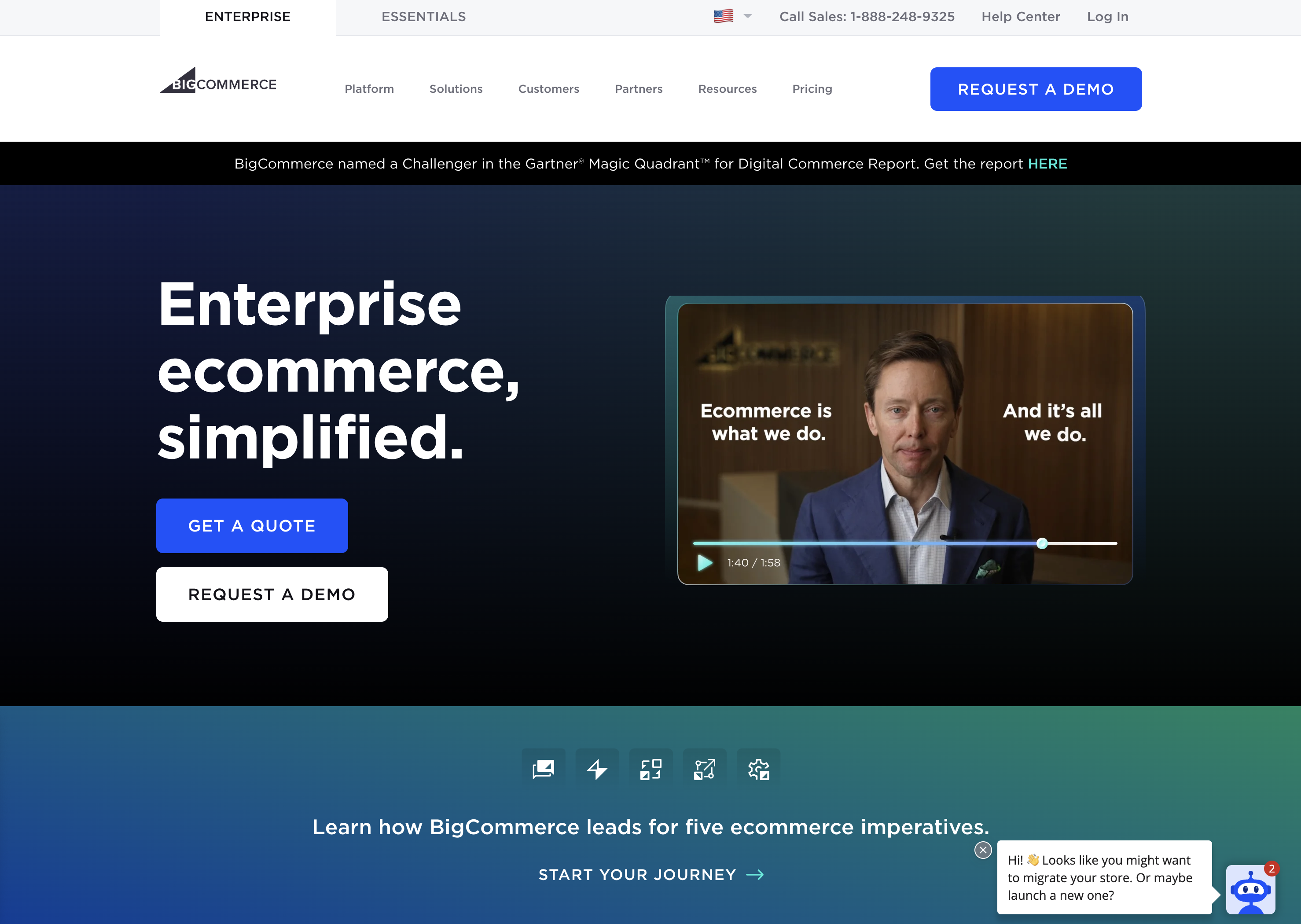 Screenshot from: jekyllrb.com, March 2024.
Screenshot from: jekyllrb.com, March 2024.Jekyll is best suited for developers, bloggers, and tech-savvy individuals who prefer a lightweight, flexible website creation platform. It’s particularly popular among the GitHub community, as it can be easily integrated with GitHub Pages for free hosting.
Jekyll requires specific technical knowledge, as users must be comfortable working with the command line and writing code. While Jekyll offers plugins and themes to extend its functionality, users may need to rely on their coding skills to customize their website fully.
One tip for getting the most out of Jekyll is to utilize its built-in blogging features, which offer a simple, intuitive way to create and manage blog posts using Markdown.
Another nuance to remember is that Jekyll generates static pages that may not be the best choice for websites requiring frequent updates or complex functionality.
Key Features:
- No programming is involved.
- SEO is built-in.
- GitHub manages redirects.
- Easy setup of custom domains.
Pros:
- No server maintenance.
- Very fast.
- Secure.
- Free hosting.
- Free SSL certificate.
- Works with GitHub as CMS.
Cons:
- It can’t create contact forms.
- No dynamic content options.
- Posts cannot be scheduled.
- Does not include image manipulation functionality.
6. Hugo
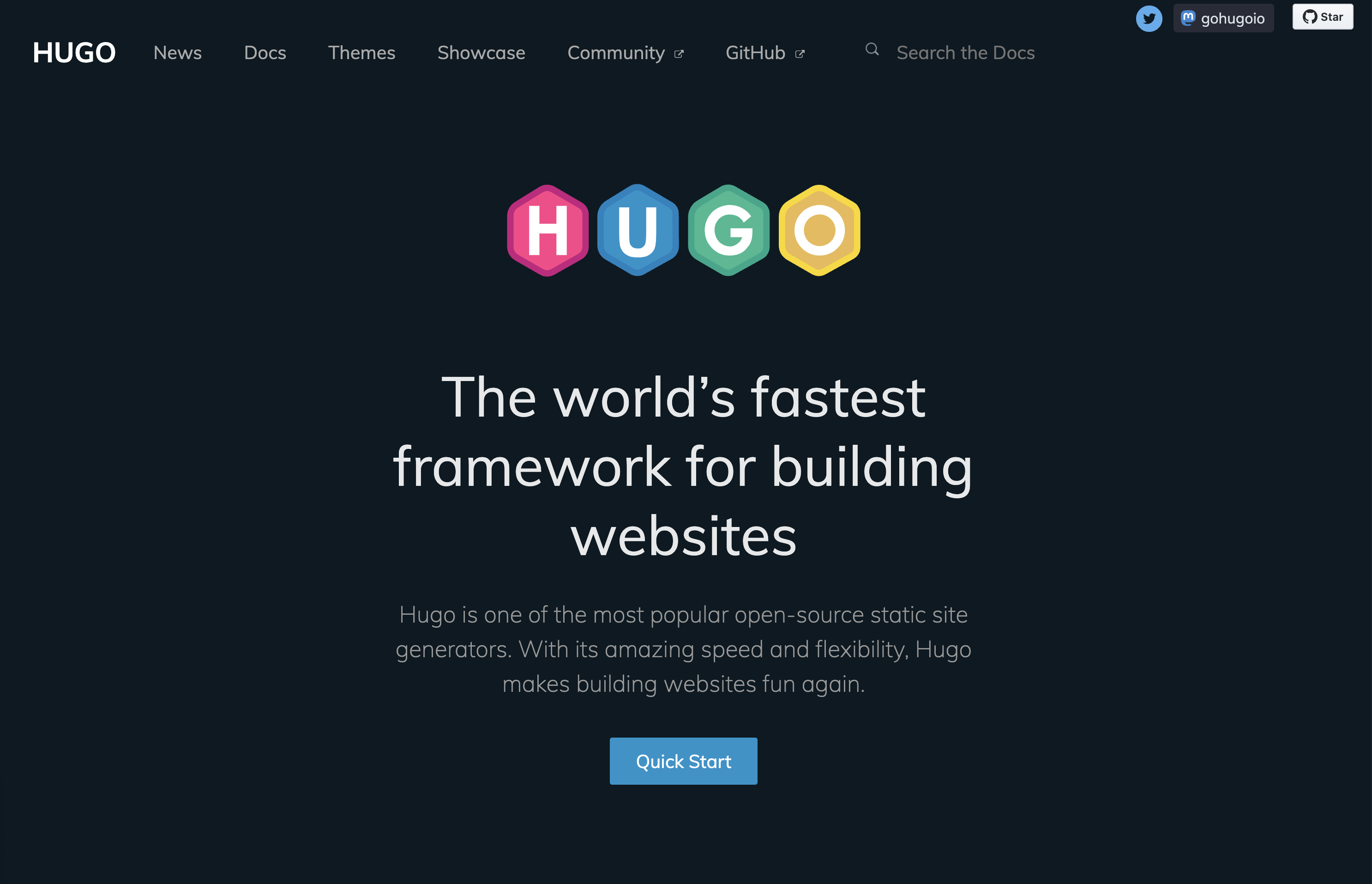 Screenshot from: gohugo.io, March 2024.
Screenshot from: gohugo.io, March 2024.Hugo is best suited for developers, bloggers, and content creators who value speed, flexibility, and simplicity. Its lightning-fast build times and static page generation make it ideal for those who frequently update their site or publish new content regularly.
While Hugo offers themes and templates to help users get started, creating a unique design may require coding skills.
One tip for getting the most out of Hugo is to leverage its built-in shortcodes, which allow users to easily add complex functionality to their web pages without writing extensive code.
Another nuance to remember is that, as a static site generator, Hugo may not be the best choice for websites that require dynamic features like user authentication or real-time data updates.
Key Features:
- Can build most websites in seconds.
- Cross-platform with easy installation.
- Allows you to host your site anywhere.
- Customizable URLs.
- “Minutes to Read” and “WordCount” functionality.
- Integrated Google Analytics and Disqus comment support.
Pros:
- It easily integrates with Google Calendar and other apps.
- Easy to use with responsive customer service.
- Multilingual capabilities are built-in.
- Extendable as needed.
Cons:
- It can’t create one-off tasks.
- It can be confusing upon initial use, particularly in templating syntax.
- No plugins are available.
- Limited text formatting features.
7. Webflow
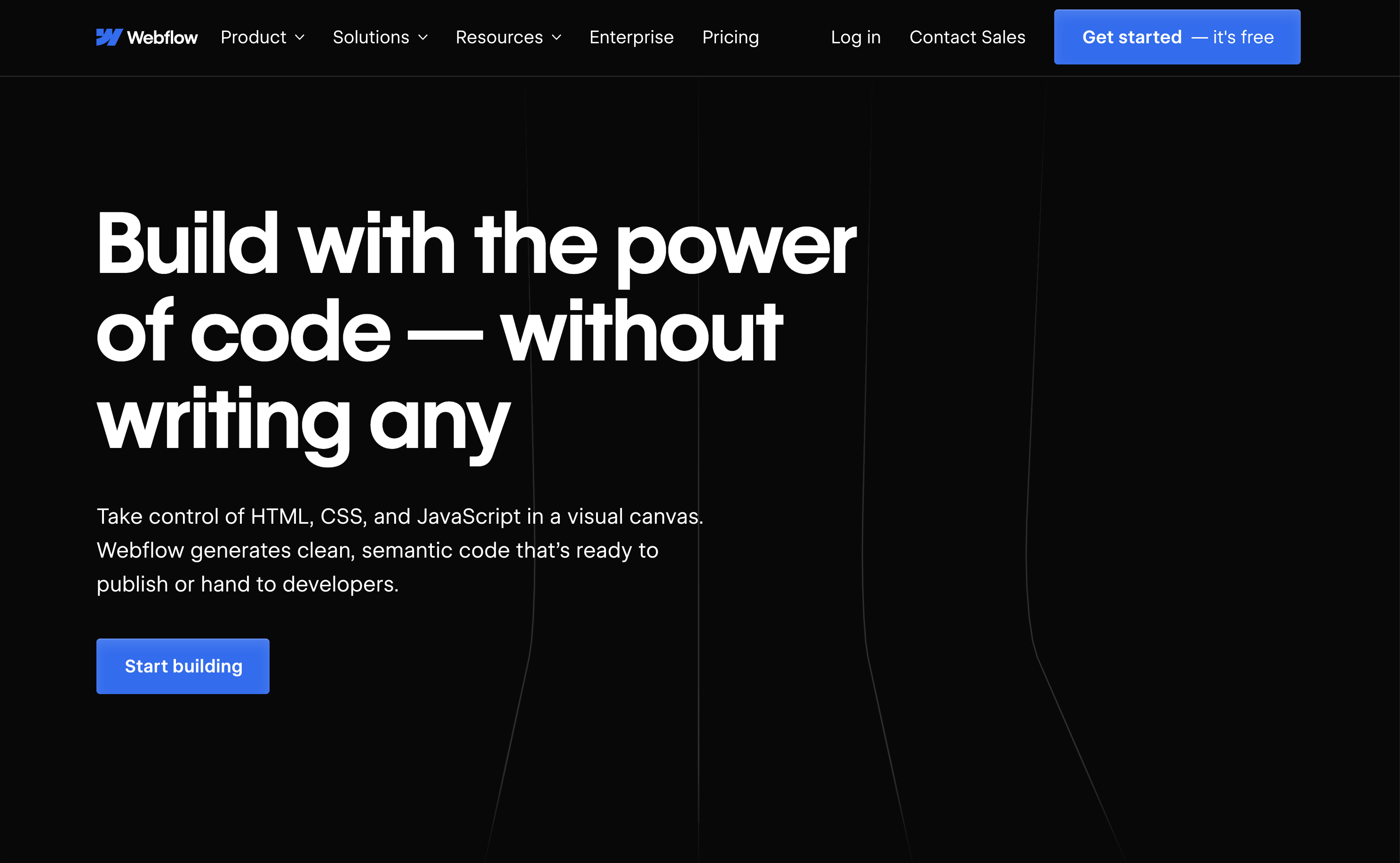 Screenshot from: webflow.com, March 2024.
Screenshot from: webflow.com, March 2024.Webflow is best suited for freelance designers and small agencies who want complete control over their website’s design without worrying about hosting, security, or performance.
One nuance of Webflow is that extending a site’s functionality is not as straightforward as installing a plugin like WordPress.
Users must either set up integrations between their Webflow site and other platforms using third-party tools like Zapier, or they can embed custom code blocks on pages to add features.
A key aspect to note about Webflow is its pricing structure. Building a site is completely free, and users only need to purchase a site plan and custom domain when they are ready to launch.
This makes it an attractive option for freelancers and small teams who want to design and prototype sites without upfront costs, paying only when they are ready to go live.
Key Features:
- More than 100 templates to choose from.
- Design is prioritized, with animation, interaction, and parallax scrolling options.
- Offers automatically generated sitemaps and customizable 301 redirects.
- Multiple payment options for ecommerce sites and automatic tax calculation.
Pros:
- Affordable plans range from free to $235 for top-tier ecommerce plans.
- Free starter plan.
- Numerous learning and help resources.
- Good range of templates.
- Good security.
Cons:
- Steep learning curve.
- Integration with social media can be frustrating.
- Advanced capabilities aren’t built-in and require integration.
8. Joomla
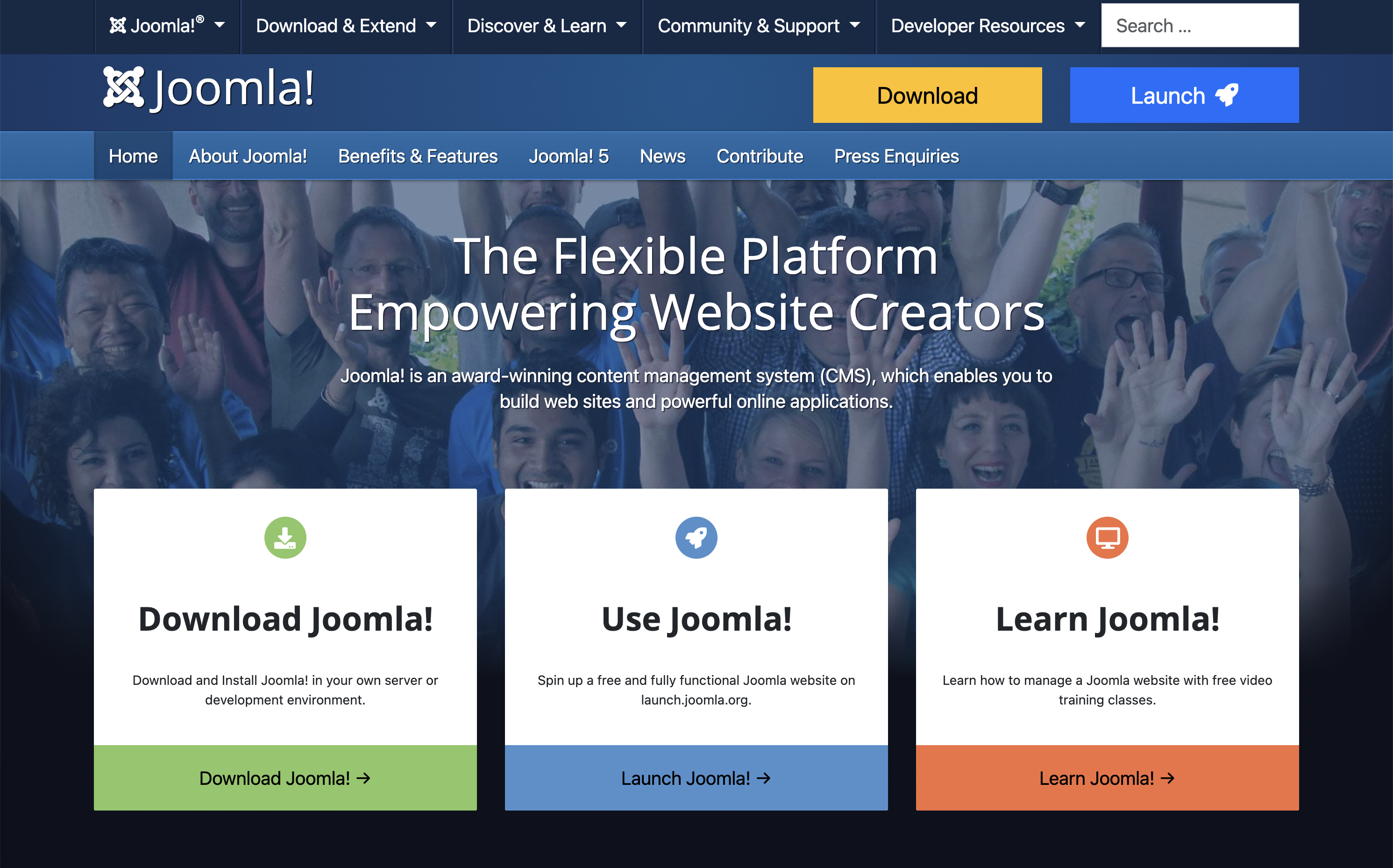 Screenshot from: joomla.org, March 2024.
Screenshot from: joomla.org, March 2024.Joomla is best suited for creating social networking, community, and membership sites. With its built-in multilingual support and advanced user and content management options, Joomla enables site owners to manage hundreds of users, create custom post types, and publish content in multiple languages.
One nuance of Joomla is that it has a steeper learning curve compared to more beginner-friendly CMSs like WordPress.
While Joomla aims to combine the power and flexibility of Drupal with the user-friendliness of WordPress, users with some web development experience will be better equipped to understand and take full advantage of Joomla’s built-in features and settings.
Users can choose from over 6,000 extensions available in the official directory to extend a Joomla site’s functionality. However, unlike WordPress plugins that can be installed with just a few clicks, Joomla extensions must be installed via the backend.
This process requires more technical know-how and may be challenging for beginners.
Key Features:
- Almost 6,000 extensions are available.
- Traditional content editing (no drag-and-drop visual editor).
- Optimized for mobile (depending on the template).
- Blog module.
- Ecommerce store.
- Social media tools.
Pros:
- Free, open-source software.
- Premade designs and templates.
- Access to source code.
Cons:
- No free subdomains or custom domains are available.
- No customer support.
- Requires a PHP-enable server to run.
- Fewer templates and extensions than WordPress.
9. Drupal
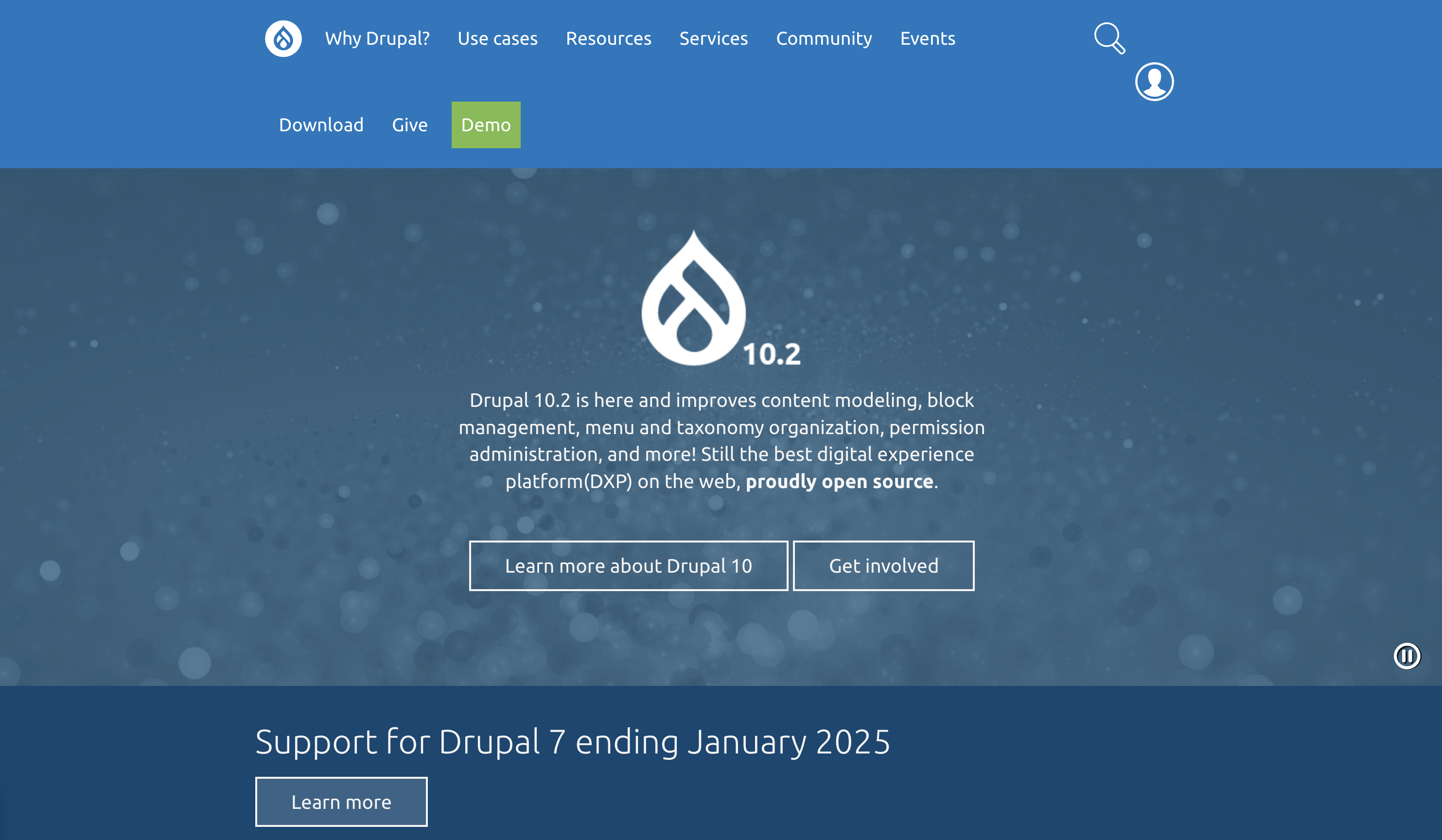 Screenshot from: drupal.org, March 2024.
Screenshot from: drupal.org, March 2024.Drupal is best suited for large corporations, government agencies, and universities with dedicated teams of developers. With its extensive customization options and ability to handle large data and heavy traffic, Drupal is ideal for complex, high-performance websites.
One key nuance of Drupal is its steep learning curve. Drupal is designed for developers or users with a strong understanding of HTML, CSS, and PHP.
Customizing a Drupal site involves working with numerous modules and themes, which can be highly configurable but require technical expertise to set up and maintain.
For organizations with the necessary technical resources, Drupal’s flexibility and robustness make it a top choice for building highly secure and customized websites.
Key Features:
- Content management system (CMS).
- Over 47,000 modules are available.
- Traditional content editing (no drag-and-drop visual editor).
- Optimized for mobile (depending on the theme you choose).
- Blog module.
- Ecommerce store.
- Social media tools.
Pros:
- Free, open-source software.
- Premade designs and templates.
- Access to source code.
- Strong security and data encryption.
Cons:
- No free subdomains.
- No customer support.
- Requires a PHP-enabled server to run.
10. DataLife Engine
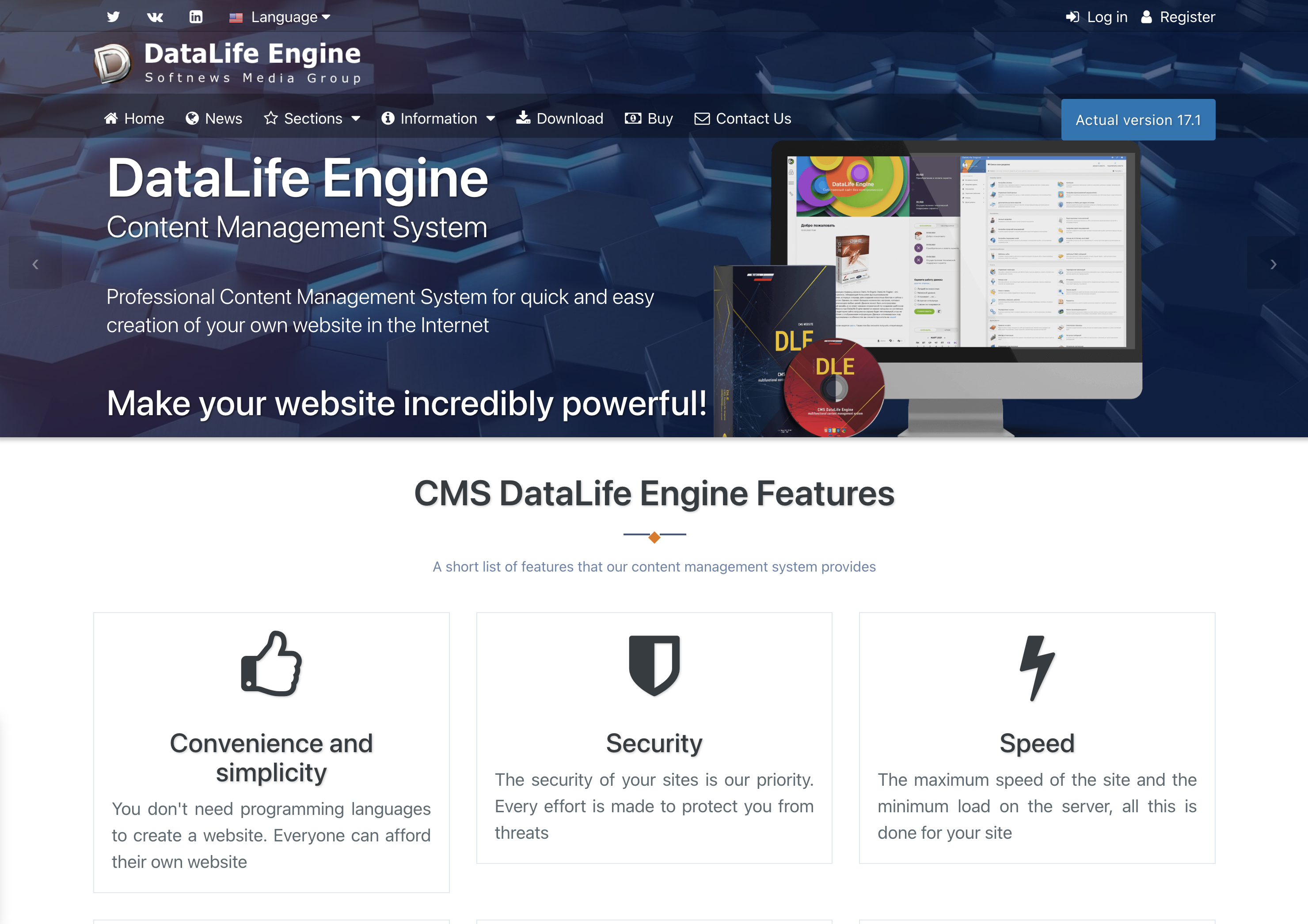 Screenshot from: dle-news.com, March 2024.
Screenshot from: dle-news.com, March 2024.DataLife Engine (DLE) is best suited for media companies, news websites, and blogs, prioritizing SEO, security, and performance. The platform’s focus on handling high traffic levels with minimal server load makes it an attractive choice for websites that expect significant visitors and must ensure a smooth user experience.
DLE’s user-friendly interface and content management features suit organizations with multiple users involved in creating and publishing well-suited content.
The platform’s ability to track statistics and automatically filter words in comments can benefit media websites and blogs that need to moderate user-generated content and analyze audience engagement.
However, there are some nuances to consider when using DLE. The limited number of plugins and themes may restrict how much websites can customize their appearance and functionality compared to other CMSs like WordPress.
It’s also important to note that while DLE supports English users, they are considered a secondary focus.
Key Features:
- Content management system (CMS).
- Designed for multiple users.
- SEO-focused.
- Tracks statistics.
- Automatically filters words in comments.
- It supports an unlimited number of categories.
- Low server load.
- Allows plugins.
Pros:
- Stores data using MySQL.
- Excellent user experience
- Websites load quickly, even on low-end servers.
- Excellent for publishing news and blog posts.
Cons:
- No free version licenses vary from $79 for basic to $199 for unlimited.
- English users are a secondary focus.
- A limited number of plugins and themes.
- The lowest license doesn’t include customer support.
11. Sitefinity
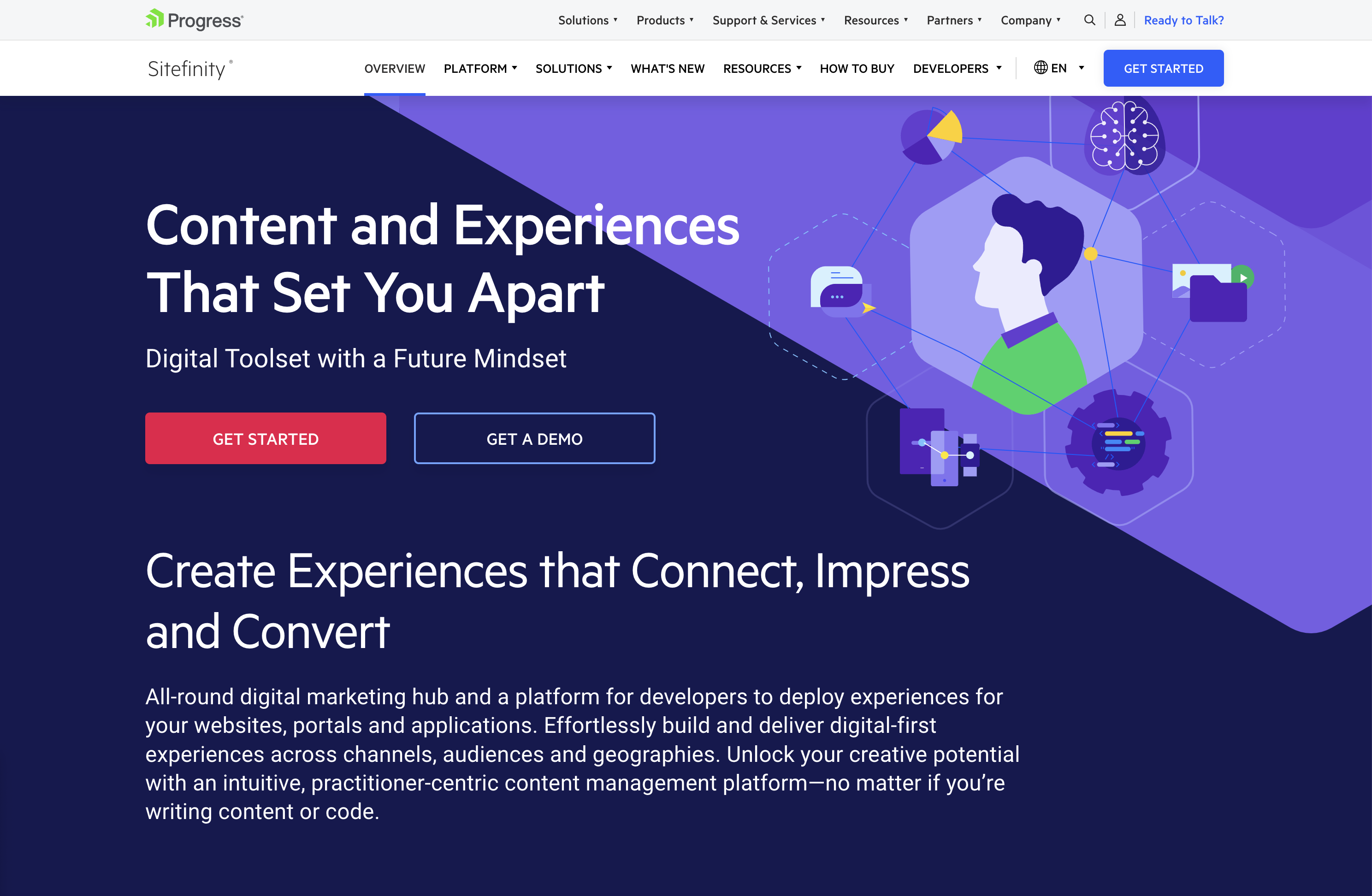 Screenshot from: progress.com/sitefinity-cms/, March 2024.
Screenshot from: progress.com/sitefinity-cms/, March 2024.Progress’ Sitefinity is best suited for organizations that manage multiple websites, brands, or marketing channels from a single platform.
The CMS’s ability to sync assets across pages and sites makes it an attractive choice for companies with a diverse online presence. It streamlines content management and ensures consistency across various touchpoints.
One notable advantage of Sitefinity is its low-cost license compared to other CMS options, which may make it an attractive choice for budget-conscious organizations.
Additionally, the minimal coding required for integration and the flexible deployment time can help businesses reduce development costs and bring their websites to market faster.
However, Sitefinity setup and administration can be challenging. Organizations may need to invest time and resources into training their teams or hiring experienced professionals to ensure a smooth implementation and ongoing management of the platform.
Key Features:
- Manage multiple sites from one location.
- Sync assets across pages and sites.
- It makes personalization simpler.
- Integrated analytics and optimization.
- Four versions include basic, marketing-focused, PaaS, and ecommerce.
- Multilingual capabilities.
Pros:
- Low-cost license compared to other CMS.
- No setup fee.
- Minimal coding is required for integration.
- Flexible deployment time shortens time to market.
- Options for marketing automation.
Cons:
- Free trial, but no free version.
- Setup and administration can be challenging.
- No mobile interface.
12. CMS Hub
 Screenshot from: hubspot.com/products/cms, March 2024.
Screenshot from: hubspot.com/products/cms, March 2024.CMS Hub, previously known as Hubspot CMS, is best suited for businesses that already use HubSpot’s marketing, sales, or service tools and want to integrate their website with their existing HubSpot ecosystem.
It combines the ease of use of a drag-and-drop website builder with the flexibility and performance of a CMS.
CMS Hub seamlessly integrates with HubSpot’s CRM platform, allowing businesses to create personalized content experiences, optimize marketing efforts, and streamline sales processes.
It also focuses on security and performance, with HubSpot handling website hosting, SSL certification, and CDN configuration.
However, while CMS Hub offers customization options, it may not be as flexible as other CMSs like WordPress or Drupal, potentially limiting businesses with particular design or functionality requirements.
Additionally, CMS Hub’s pricing model can be expensive compared to other CMS options, so companies must carefully consider their budget and weigh the benefits of its all-in-one approach.
Key Features:
- Cloud-based.
- Includes SEO recommendations.
- Includes numerous themes and responsive templates.
- Fully integrated CRM.
- Drag-and-drop webpage editor.
- Built-in security.
Pros:
- Adaptive A/B testing helps you identify the best page layout.
- All-in-one publishing tools.
- Built-in SEO tools.
- Supports smart content with personalized rules.
- Mobile pages supported with Google AMP.
Cons:
- Does not support ecommerce.
- No automatic backup and recovery.
13. Contentful
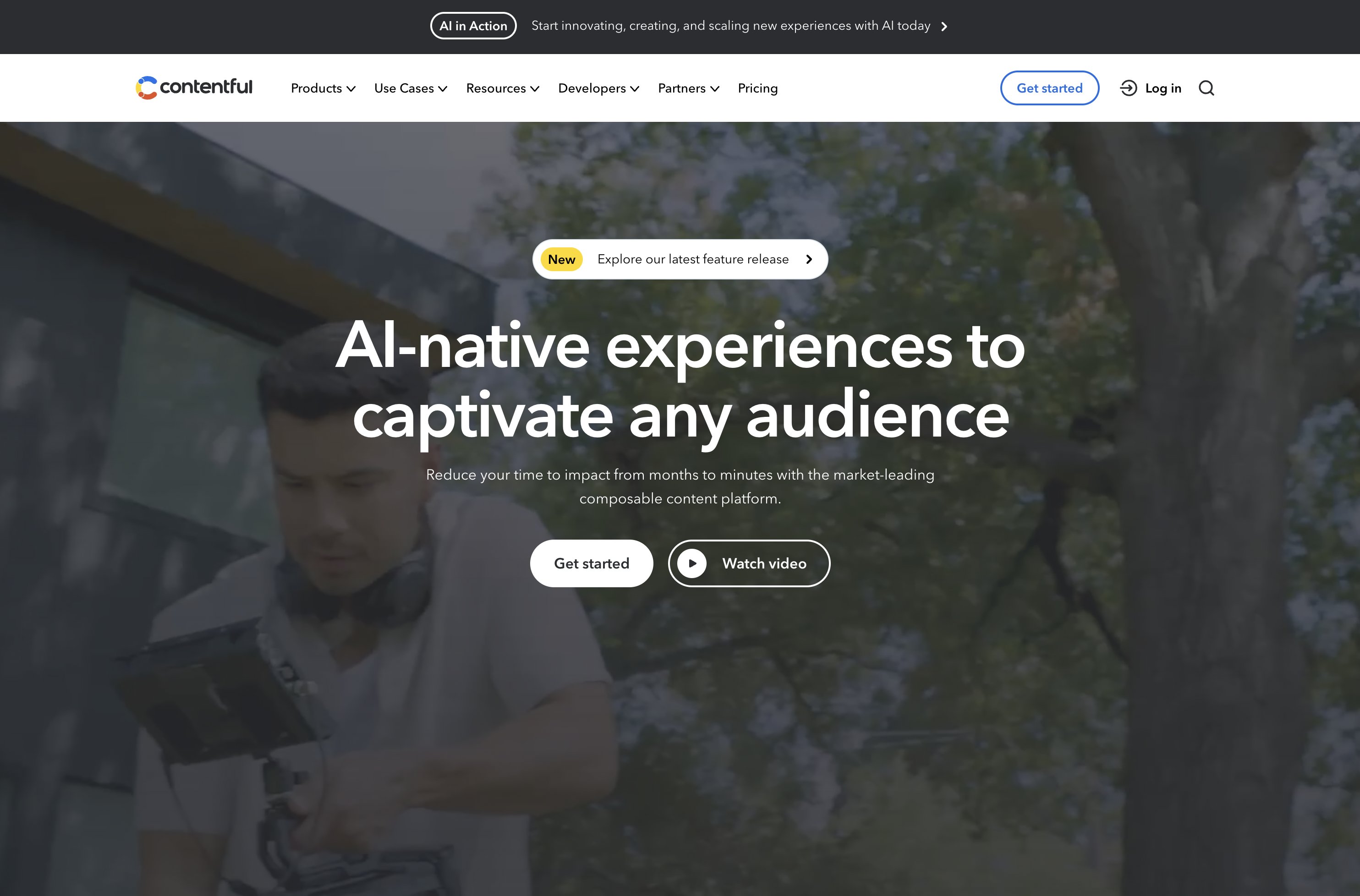 Screenshot from: contentful.com, March 2024.
Screenshot from: contentful.com, March 2024.Contentful is a headless CMS best suited for businesses and developers requiring a flexible, scalable, and customizable content management solution.
It’s particularly well-suited for organizations delivering content across multiple channels, such as websites, mobile apps, and IoT devices.
One of Contentful’s key advantages is its content modeling capabilities. The platform allows users to create custom content models that can be easily adapted to their needs.
When using Contentful, it’s important to remember that it’s a headless CMS that focuses on content management and delivery rather than providing a built-in front end or presentation layer.
Developers must build a front end using their preferred tools and frameworks and then integrate with Contentful’s API to retrieve and display the content.
Another aspect to consider is the learning curve associated with Contentful. While the platform is designed to be user-friendly, it may take some time for content editors and managers to become familiar with its interface and content modeling concepts.
Features:
- RESTful API gives you complete control over assets, translations, and versions.
- Customizable interface and framework that works across third-party component providers.
- It provides regional autonomy, so pieces in multiple languages and time zones can be published globally.
- Content modeling allows you to structure content by channel.
- Single sign-on and secure access.
Pros:
- Focus on integration simplifies the technology stack.
- User-friendly with a clean interface.
- Free version for up to five users.
- Good scalability.
Cons:
- Expensive for an upgraded version ($489/month).
- Poor internal search tools.
- Modeling content can be tricky.
14. Adobe Experience Manager
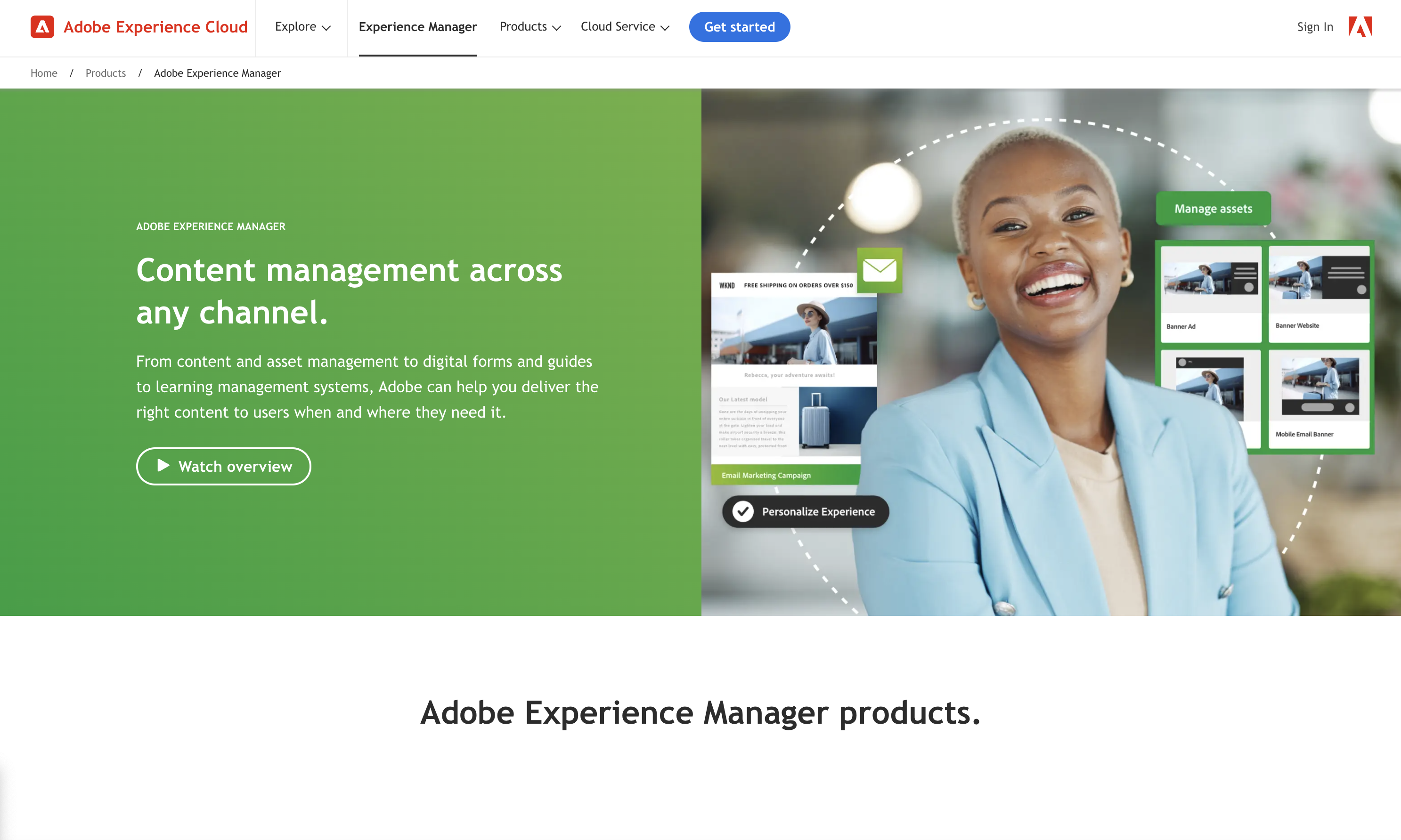 Screenshot from: business.adobe.com/products/experience-manager/adobe-experience-manager.html, March 2024
Screenshot from: business.adobe.com/products/experience-manager/adobe-experience-manager.html, March 2024Adobe Experience Manager (AEM) is an enterprise-level CMS best suited for large organizations with complex content management needs and a significant budget. AEM’s target audience includes global brands, financial institutions, healthcare providers, and government agencies.
One of AEM’s key strengths is its tight integration with other Adobe products, such as Analytics, Target, and Creative Cloud.
This integration allows organizations to leverage the full power of Adobe’s digital marketing suite, enabling them to create, manage, and optimize content and experiences across the entire customer journey.
AEM also offers advanced features like intelligent content delivery, AI-powered content tagging, and multi-site management, making it a comprehensive solution for enterprise content management.
The platform’s complexity and extensive feature set can overwhelm smaller organizations or teams with limited resources. Additionally, AEM’s licensing and implementation costs are among the highest in the market, making it a significant investment for any organization.
Key Features:
- Comprehensive marketing platform.
- End-to-end digital document solution.
- Enterprise-level security.
- Analytics included.
- Intelligent search.
- Scalable to your needs.
Pros:
- Streamlines workflows by keeping everything on one platform.
- Individual marketers can handle authoring and publishing.
- Easy authorization of workflow.
- Can handle massive content loads.
- Can manage multiple sites at once.
Cons:
- Steep learning curve.
- Requires different sign-ins to access other areas.
- Doesn’t integrate well with external DAMs.
- Not ideal for communities and forums.
Ecommerce Platforms
15. BigCommerce
 Screenshot from: bigcommerce.com, March 2024.
Screenshot from: bigcommerce.com, March 2024.BigCommerce is a hosted ecommerce platform best suited for businesses of all sizes looking to create and manage an online store. It caters to many users, from small and medium-sized businesses to large enterprises.
One of BigCommerce’s key advantages is its scalability. The platform accommodates businesses as they grow, offering features like unlimited products, file storage, and bandwidth.
BigCommerce also provides a range of advanced ecommerce functionalities, such as multi-channel selling, abandoned cart recovery, and built-in SEO tools, which can help businesses optimize their online sales performance.
When considering BigCommerce, it’s important to remember that while the platform offers a wide range of features, some of the more advanced functionalities may require a higher-tier plan or additional costs.
BigCommerce also enforces certain design limitations on its themes, which may restrict the level of customization available without diving into custom coding.
Key Features:
- Full hosting solution.
- No software to self-install.
- Drag-and-drop visual builder.
- Extensions are available.
- Optimized for mobile.
- Blog module.
- Ecommerce store.
- Social media tools.
Pros:
- High level of customization options.
- Over 100 themes to choose from (including some free).
- No platform commission fees.
- Free subdomain available.
- Customer support.
Cons:
- No free version is available.
- No access to source code.
- Pricing is based on revenue, which isn’t great if you have tight margins.
16. Shopify
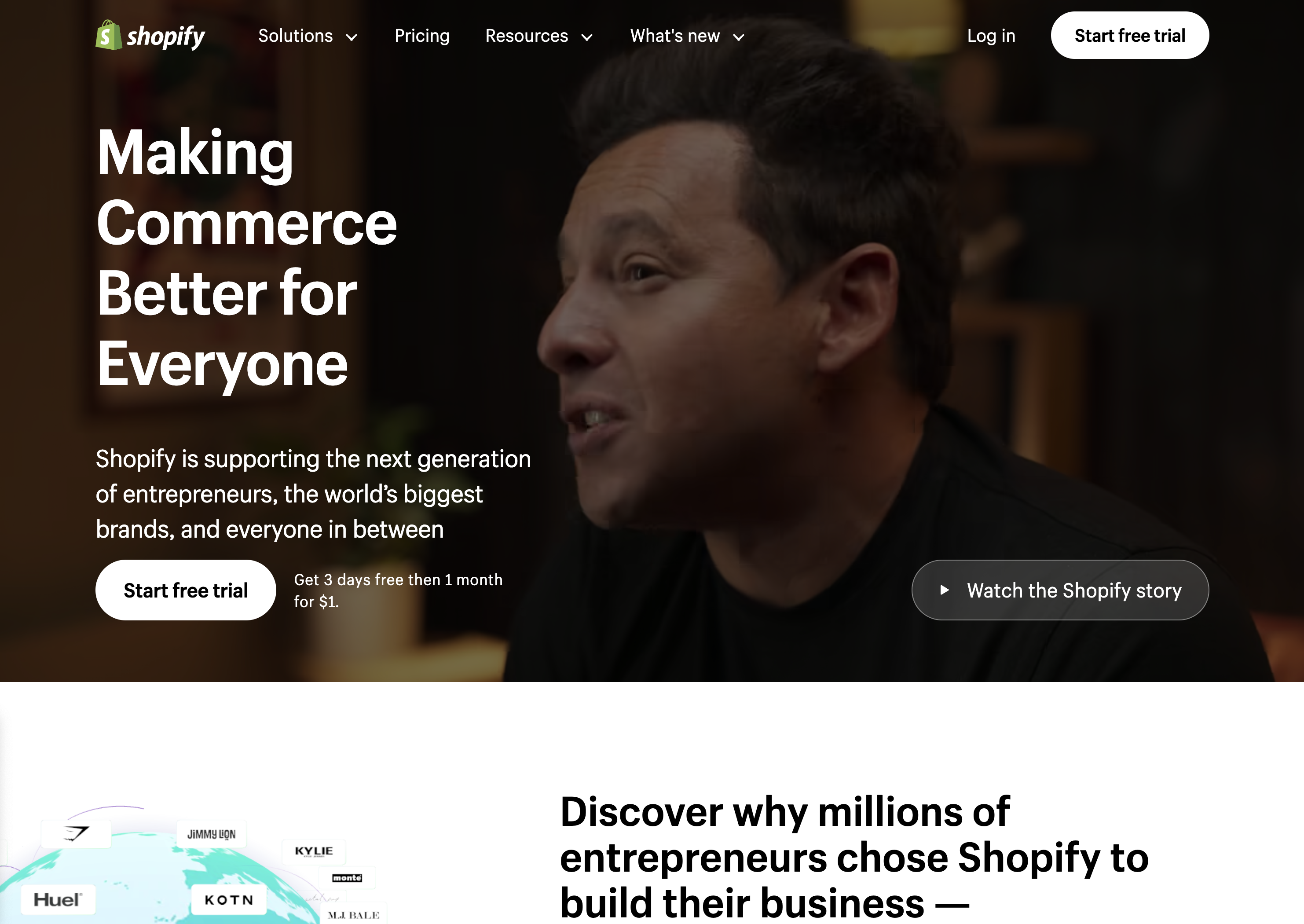 Screenshot from: shopify.com, March 2024.
Screenshot from: shopify.com, March 2024.Shopify is an ecommerce platform well-suited for entrepreneurs and small business owners who want to establish an online presence quickly without extensive technical expertise.
Shopify’s extensive app marketplace allows businesses to extend its functionality and customize their online store to meet specific needs.
The platform also provides built-in features like inventory management, payment processing, and abandoned cart recovery to help streamline operations and optimize sales performance.
When using Shopify, consider the platform’s transaction fees, which vary depending on the payment gateway. Some advanced design changes may require HTML, CSS, and Liquid knowledge.
Despite these considerations, Shopify remains a top choice for businesses seeking a reliable, scalable, and feature-rich ecommerce platform.
Key Features:
- Full hosting solution.
- No software to self-install.
- Drag-and-drop visual builder.
- Extensions are available.
- Optimized for mobile.
- Blog module.
- Ecommerce store.
- Social media tools.
Pros:
- All-in-one website builder and platform.
- Premade designs and templates.
- Free subdomain available.
- Customer support.
Cons:
- No free version is available.
- No access to source code.
- Platform commission fees.
17. Magento
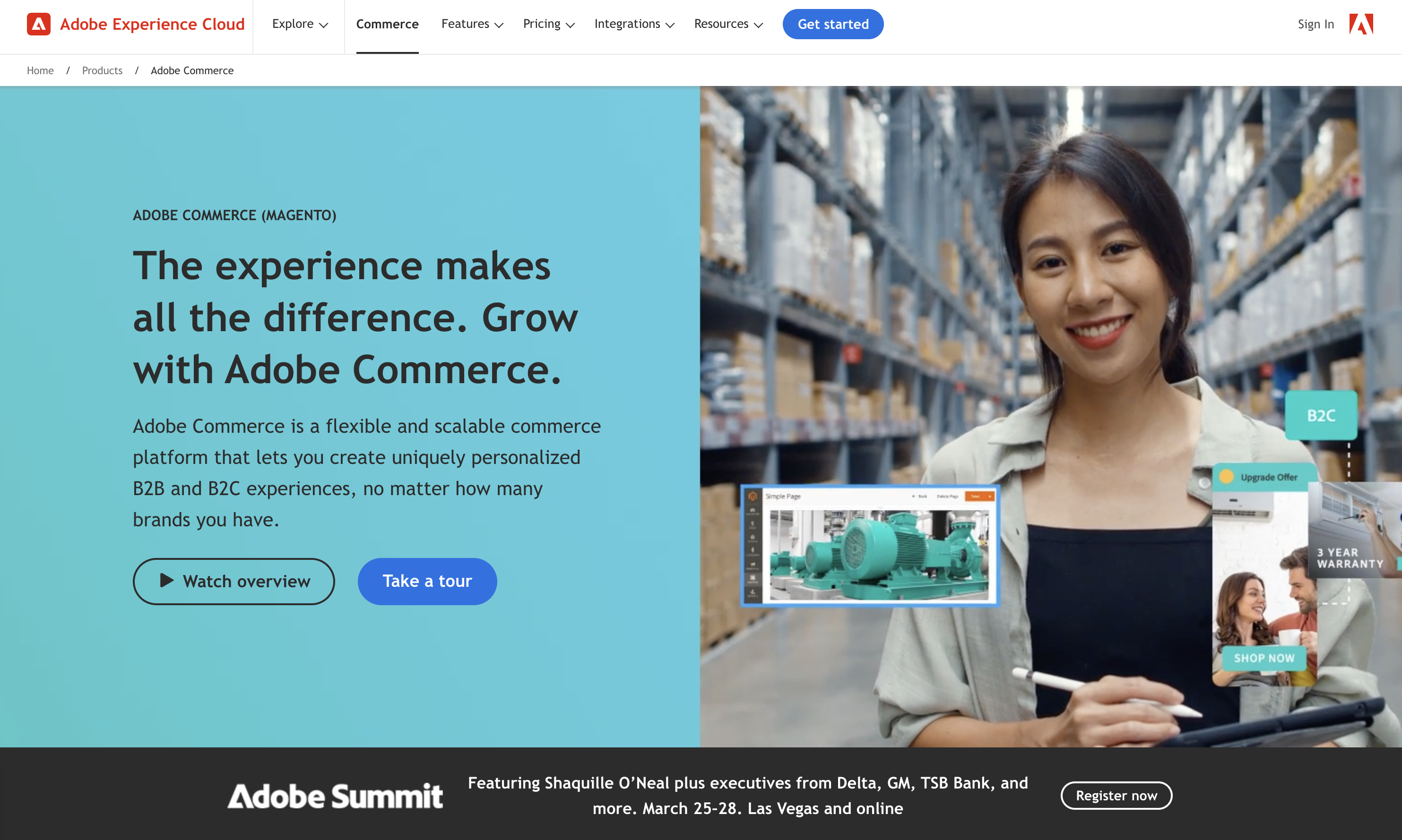 Screenshot from: business.adobe.com/products/magento/magento-commerce.html, March 2024
Screenshot from: business.adobe.com/products/magento/magento-commerce.html, March 2024Magento is an open-source ecommerce platform best suited for medium to large enterprises with complex online selling needs.
Magento’s flexibility and scalability come with a steeper learning curve than other ecommerce platforms. It requires more technical expertise to set up, customize, and maintain, making it less suitable for small businesses or users without web development knowledge.
When using Magento, remember that its powerful features and customization options can impact website performance if not optimized properly.
Choosing a reliable hosting provider and working with experienced Magento developers is crucial for ensuring optimal store performance and security.
Key Features:
- Option to pay for Magento Commerce for a complete hosting platform or download the free, open-source software to install on your web server.
- Drag-and-drop visual builder.
- Extensions are available.
- Optimized for mobile.
- Ecommerce store.
- Social media tools.
Pros:
- All-in-one ecommerce platform or open-source ecommerce software package.
- Free version available.
- Designed for large-scale ecommerce.
- Premade designs and templates.
- Free subdomain available (mainly for setup and testing purposes).
- Customer support (paid version only).
- Access to source code with the downloadable version.
Cons:
- No blog module, although you can add it as an extension.
- Not optimized for web projects or website purposes outside of ecommerce.
- The steep learning curve for inexperienced users.
- A large investment for small-scale ecommerce.
18. PrestaShop
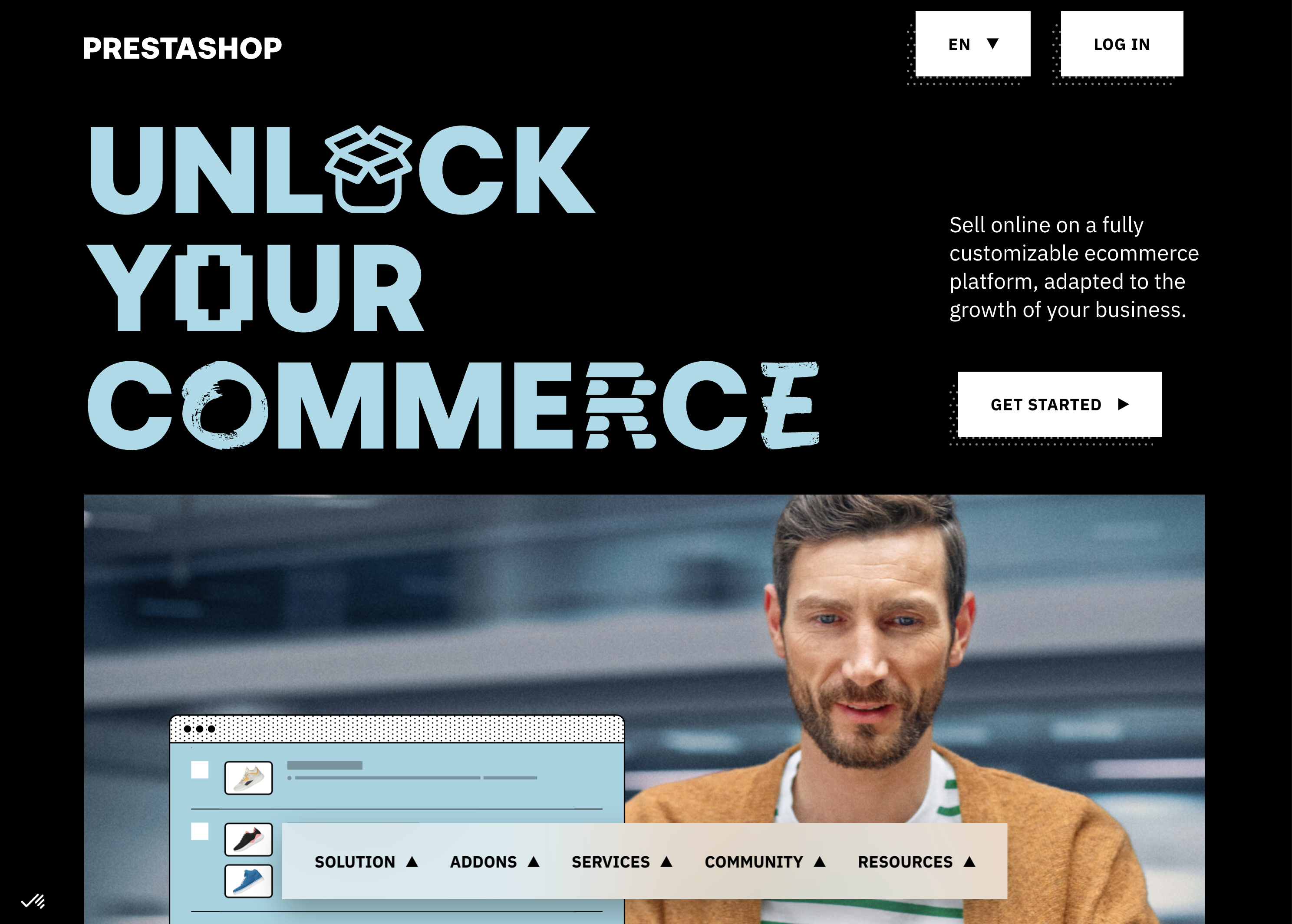 Screenshot from: prestashop.com, March 2024.
Screenshot from: prestashop.com, March 2024.PrestaShop is an open-source ecommerce platform best suited for small to medium-sized businesses looking for a cost-effective and customizable solution.
PrestaShop offers a wide range of themes and modules, allowing businesses to customize their online store’s appearance and functionality. The platform also has a strong community of developers and users, providing support and resources for store owners.
While PrestaShop is generally easy to use, some advanced customizations may require coding knowledge. Additionally, the number of installed modules can impact the platform’s performance.
Key Features:
- Customizable to your needs, including themes and features.
- Includes backend tools like payments, shipping and data.
- Community of translators for multilanguage digital stores.
- Secure payment modules.
- Scalable.
- Includes demographic assistance.
Pros:
- Free version available.
- Open source so that you can customize your site to your needs.
- 5,000+ themes, modules, and services are available with the premium plan.
- Excellent user experience.
Cons:
- Limited scalability.
- No support team.
- Initial setup requires some programming knowledge.
19. OpenCart
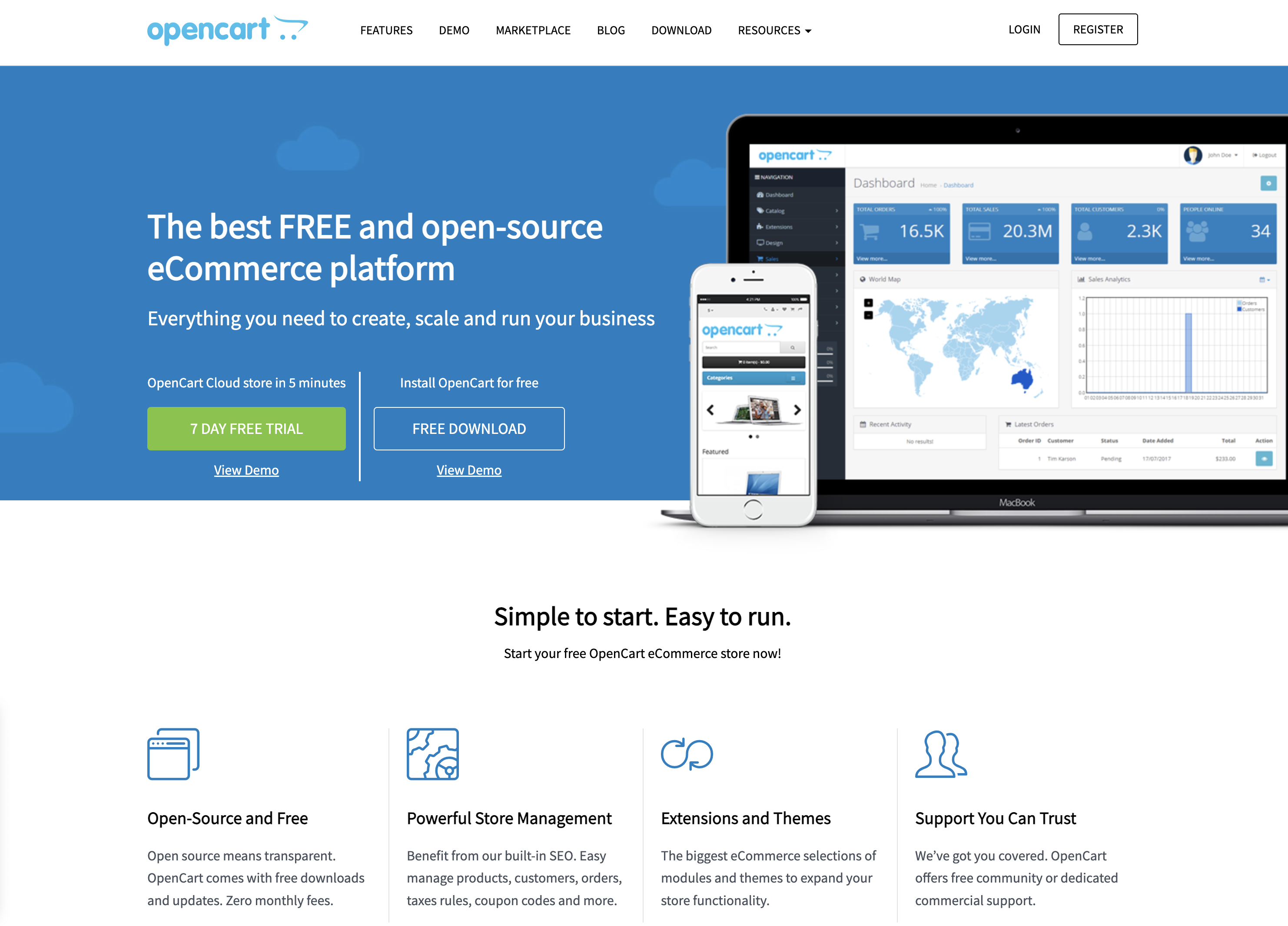 Screenshot from: opencart.com, March 2024.
Screenshot from: opencart.com, March 2024.OpenCart is a free, open-source ecommerce platform best suited for small—to medium-sized businesses with limited budgets.
OpenCart offers a decent range of features and extensions, allowing businesses to customize their online store. However, its marketplace is smaller than other platforms, which may limit advanced functionality options.
When using OpenCart, be mindful of its performance limitations as the store grows. Optimizing and carefully selecting extensions may be required to maintain a smooth user experience.
Additionally, its simplicity may not be suitable for businesses with complex ecommerce needs.
Features:
- The administrator dashboard gives you information at a glance.
- User management allows you to assign permissions and separate access.
- Allows you to run multiple stores from one dashboard.
- Customizable variables let you include options for sizes, colors, or anything else.
Pros:
- The platform is entirely free, as are many add-ons.
- Extensive metrics and reports were provided.
- Works with your current payment gateway.
- Comes with dedicated technical support.
- Flexible.
Cons:
- Often creates duplicate pages, which can cause SEO problems.
- Not all extensions, modules, plugins, and add-ons work well together.
- Checkout can be slow, particularly if you have numerous plugins.
- Can be difficult to import a list of inventory.
- Requires some degree of technical ability for optimal use.
Blogging Platforms
20. Medium
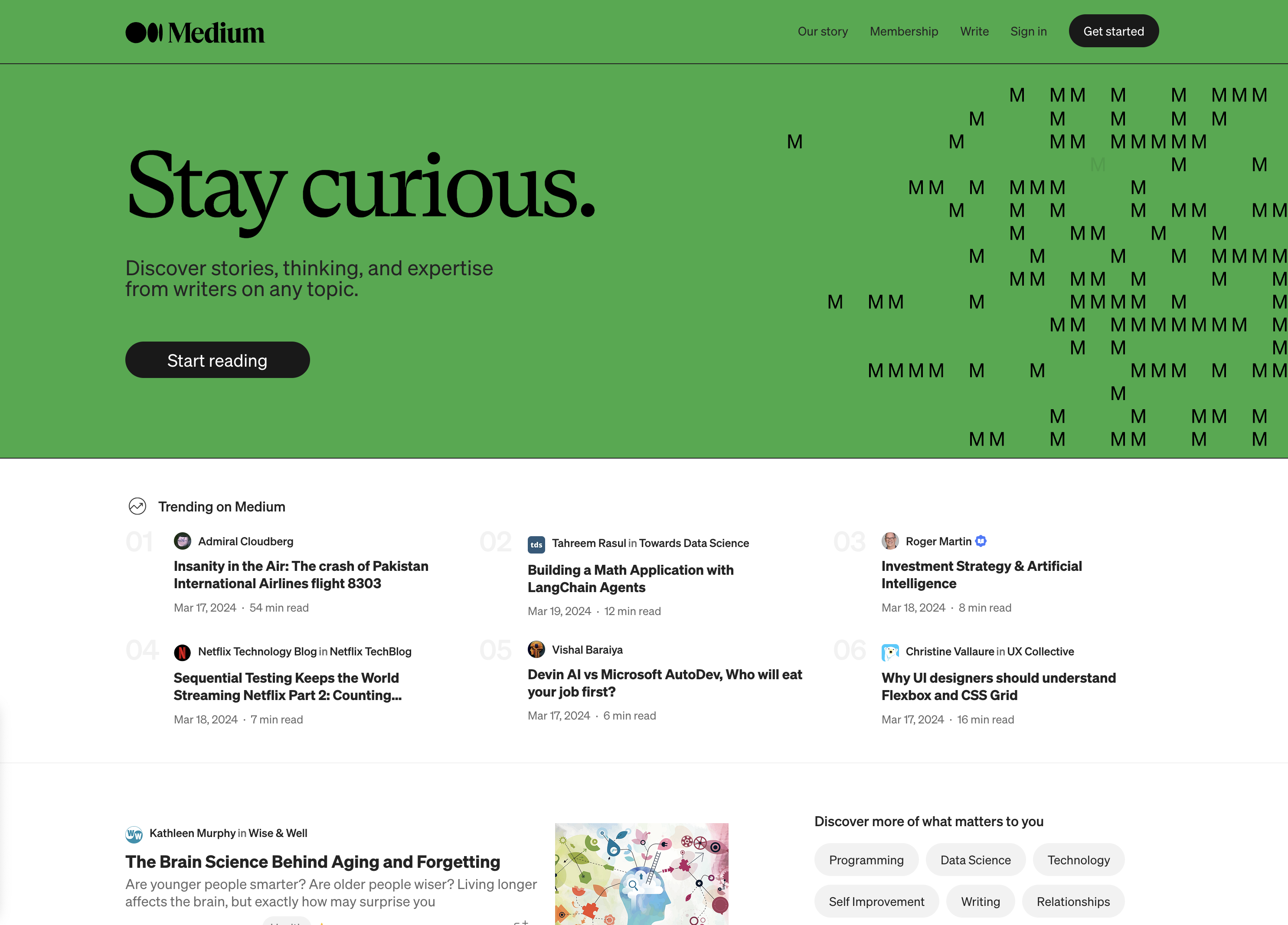 Screenshot from: medium.com, March 2024.
Screenshot from: medium.com, March 2024.Medium is a publishing platform best suited for individual bloggers, writers, and content creators who want to share their ideas and stories with a built-in audience.
Medium’s clean and minimalistic interface allows readers to concentrate on the content. The platform also offers a built-in social network, making it easy for writers to connect with readers and other creators.
However, this simplicity comes with limited customization options for branding and design.
When using Medium, it’s important to understand that the platform controls the distribution and monetization of content. While this can lead to increased exposure, it also means less control over the presentation and ownership of your content compared to self-hosted solutions.
Key Features:
- Full hosting solution.
- No software to self-install.
- Optimized for mobile.
- Blog module.
- Limited social media tools.
Pros:
- A community site for blogs.
- Free version available.
- Medium Partner Program to earn revenue.
- Customer support.
Cons:
- No extensions.
- No ecommerce stores.
- No premade designs or themes.
- No free subdomains.
- No third-party extensions.
- No access to source code.
21. Ghost
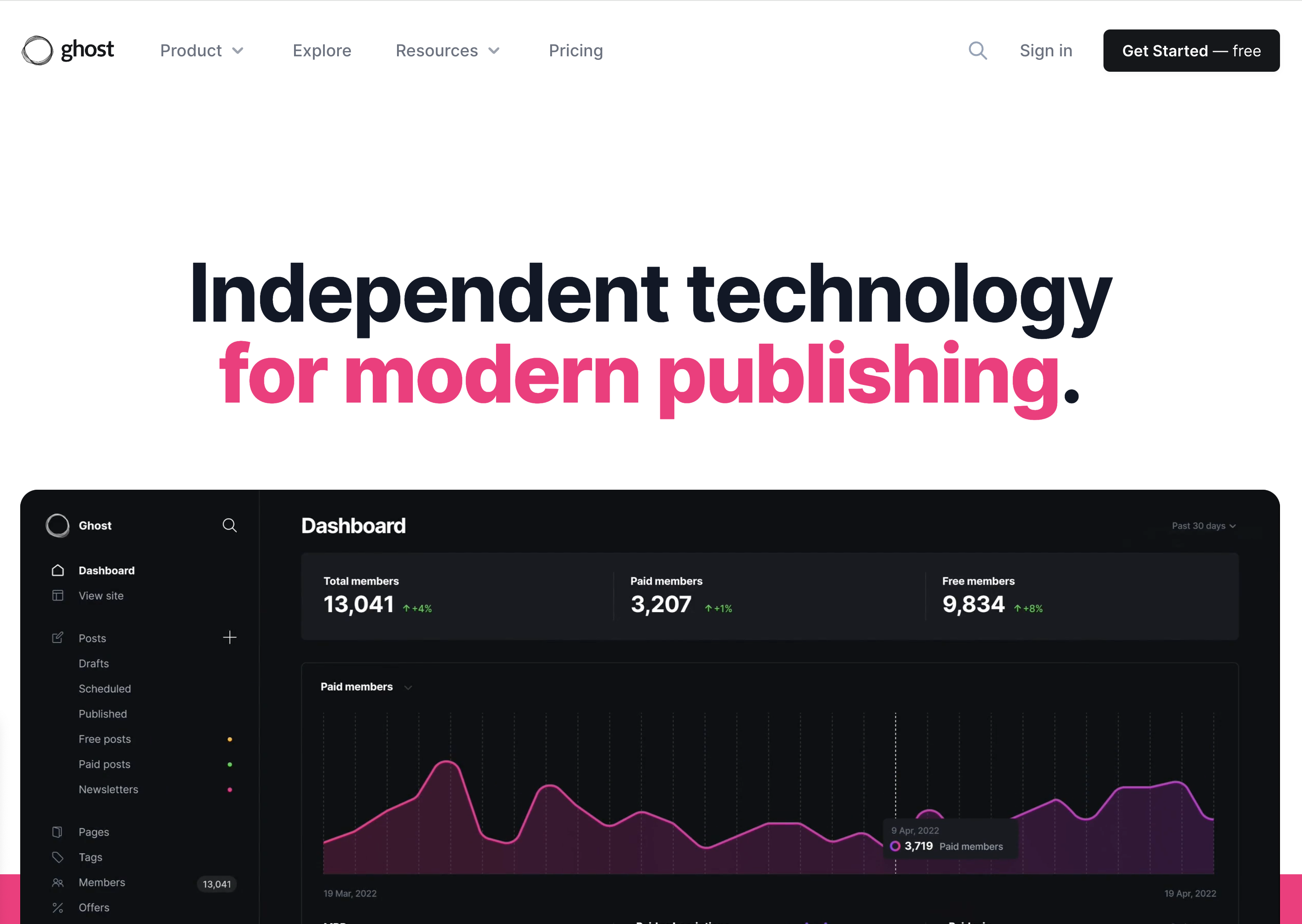 Screenshot from: ghost.org, March 2024.
Screenshot from: ghost.org, March 2024.Ghost is a lightweight, open-source publishing platform best suited for bloggers, writers, and small publications who value simplicity and performance. It’s designed for users who want a clean, focused writing experience without the complexity of more feature-rich CMS platforms.
Ghost offers a simple, intuitive editor and a minimalistic default theme, allowing users to create and publish content quickly.
The platform also provides built-in SEO features and supports memberships and subscriptions, making it a good choice for content creators looking to monetize their work.
As Ghost primarily focuses on publishing, it may not be the best fit for users who require extensive customization options or advanced functionality beyond blogging.
Key Features:
- You can subscribe through Ghost’s hosting platform or download the free, open-source software to install on your web server.
- Basic drag-and-drop visual builder.
- Extensions are available through integrations with other tools.
- Optimized for mobile.
- Blog module.
- Ecommerce store (subscription only).
- Social media tools.
Pros:
- All-in-one website builder and platform.
- Free version available.
- Premade designs and templates.
- Free subdomain available with the paid version.
- Customer support.
- Access to source code.
Cons:
- Not compatible with all third-party web hosts.
- Highly specialized with limited capabilities beyond blogging.
- Not built to scale up into a business site or complex website.
22. Tumblr
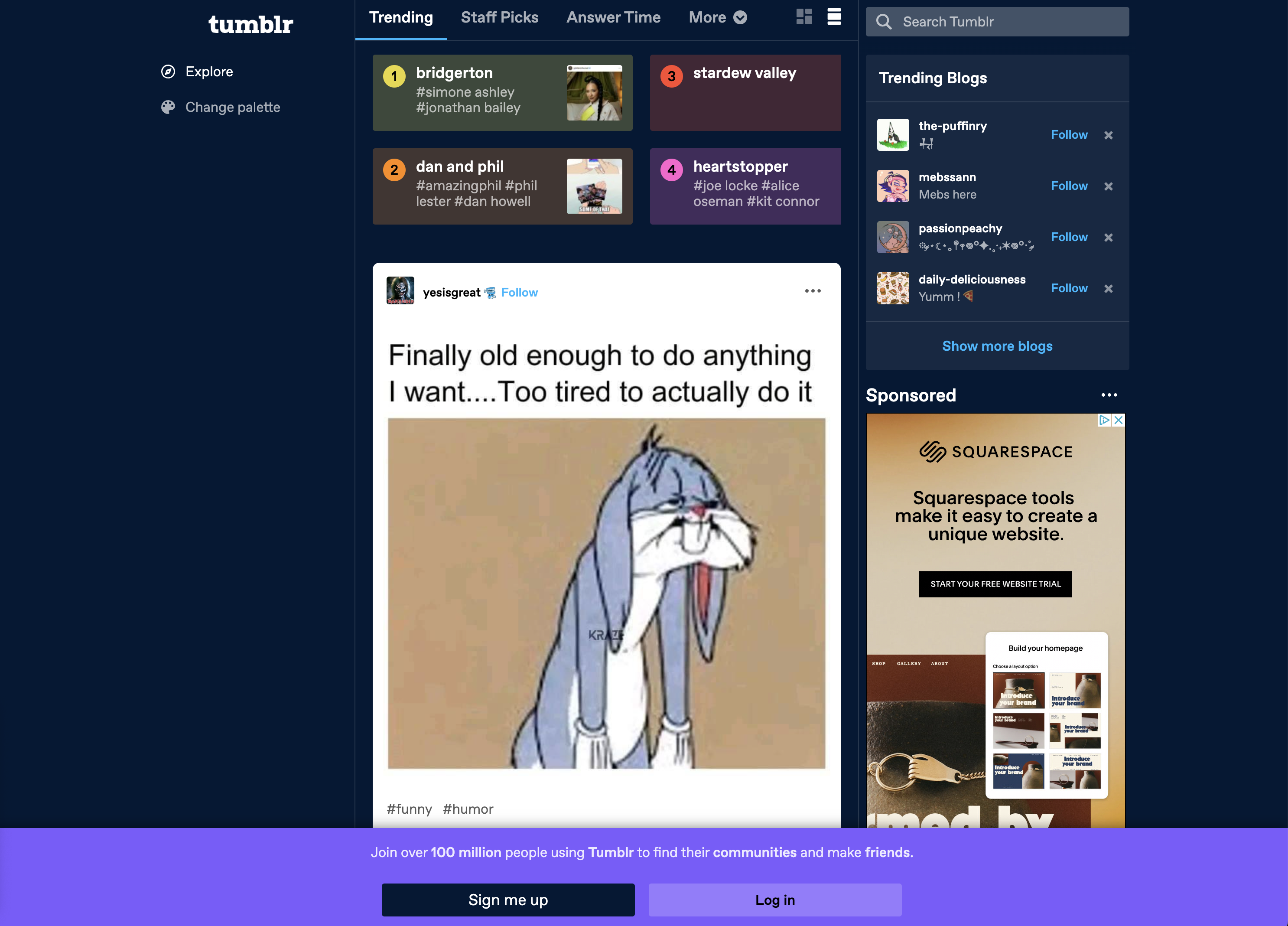 Screenshot from: tumblr.com, March 2024.
Screenshot from: tumblr.com, March 2024.Tumblr is a microblogging and social networking platform best suited for younger audiences who enjoy sharing short-form multimedia content.
Tumblr’s emphasis on community and content discovery makes it easy for users to connect with others who share similar interests. The platform’s reblogging feature spreads content quickly, increasing visibility and engagement.
When using Tumblr, it’s important to understand the platform’s unique culture and demographics. Tumblr is known for its diverse, often niche communities, which can be both a strength and a challenge for brands and marketers.
Additionally, while Tumblr offers some customization options, it may not be the best choice for users who require a highly professional or branded online presence.
Key Features:
- Features strong social media functionality.
- Customizable.
- Google Analytics Integration.
- Unlimited storage.
- Ad-free blog themes.
- Free SSL certification.
Pros:
- Free to use; no upgrades are required to access all features.
- Free web hosting.
- User-friendly and easy to set up.
- No storage limits.
- Can post audio, video, images, gifs, and more.
Cons:
- Daily posting limit (250/day).
- Files must be under 10 MB.
- No plugins.
- Safety and security leave something to be desired.
- Unsuited to long-form content.
23. Bluehost
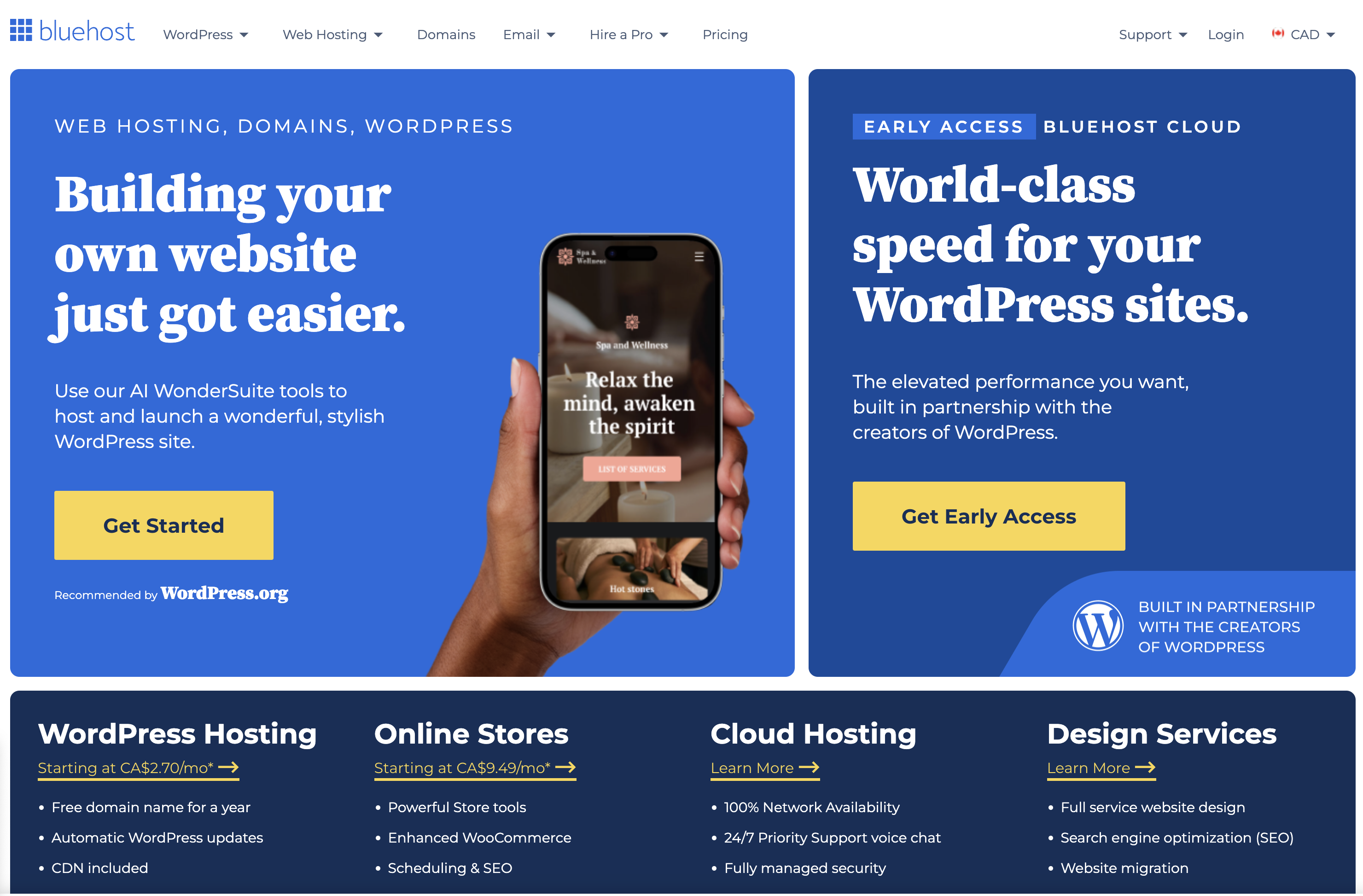 Screenshot from: bluehost.com, March 2024.
Screenshot from: bluehost.com, March 2024.Bluehost is a web hosting provider best suited for beginners and small businesses looking for an affordable, easy-to-use hosting solution.
Bluehost’s advantages are its user-friendly interface and one-click installations for popular CMS platforms like WordPress.
This makes it easy for users with limited technical knowledge to set up and manage their websites. Bluehost also provides 24/7 customer support and a free SSL certificate with each hosting plan.
While Bluehost is known for its reliability and performance, it may not be the best choice for websites with high traffic or complex requirements. Some users have reported issues with slow loading speeds and limited storage space on shared hosting plans.
Key Features:
- Domain names can be purchased through Bluehost.
- Versatile hosting options let you choose what works best for you.
- Dedicated servers and virtual private servers are available.
- A variety of plans are available based on your needs.
- Comes with customer service chat options.
Pros:
- The first term is inexpensive.
- Lots of storage and unlimited bandwidth.
- Good uptime.
- Free SSL certificates.
Cons:
- Extra features come with added costs, which can get pricey.
- High renewal rates.
- Speed could be better.
- All servers are U.S.-based.
24. Blogger
 Screenshot from: blogger.com, March 2024.
Screenshot from: blogger.com, March 2024.Blogger is a free, beginner-friendly blogging platform best suited for hobbyists, casual bloggers, and those who want to start a blog without investing in a self-hosted solution. It’s ideal for users who prioritize simplicity and ease of use over advanced customization options.
Blogger offers a straightforward, intuitive interface that makes it easy for users to create and publish blog posts.
The platform provides a selection of customizable templates and allows users to add gadgets and widgets to enhance their blog’s functionality. However, unlike other blogging platforms, Blogger’s design and customization options are relatively limited.
Blogger’s simplicity and lack of advanced features may make it unsuitable for professional bloggers or those looking to create a more sophisticated online presence.
Features:
- Clear analytics.
- Included layout/themes.
- Monetization options, including Google Adsense integration.
- Uses Google security.
- Unlimited storage.
Pros:
- Free to use.
- Extremely user-friendly.
- Free SSL security.
- Good uptime.
Cons:
- You don’t own your website.
- Fewer options and control over design.
- Limited support.
- Hard to port to a different platform.
Community Management
25. vBulletin
vBulletin is a proprietary forum software best suited for businesses, organizations, and communities looking to create and manage an online discussion platform.
vBulletin offers many features, including private messaging, user groups, and content management tools, making it a powerful solution for managing large, active communities.
The platform also provides a high level of customization, allowing administrators to tailor the look and feel of their forum to match their brand or website.
One of the primary considerations when using vBulletin is its licensing cost, which can be a significant investment for some users.
Additionally, while vBulletin offers a range of customization options, some technical knowledge may be required to optimize and maintain the platform entirely.
Key Features:
- Built-in SEO and security.
- Includes a chat app.
- Easy to get started.
- Built-in applications.
- Optimized for mobile users.
- Blogging functionality.
- Fully customizable.
Pros:
- Frequent patches and bug fixes.
- Customer support.
- Easy to install and get started.
- Designed to host forums.
- Includes templates.
Cons:
- No free option.
- Limited features compared to some other platforms.
- Requires some tech skills to take full advantage of the functionality.
- It can’t customize code for the cloud-based version.
Which One Is Right For You?
With so many options, determining the right alternative to WordPress depends on your specific needs and goals.
For individuals and small businesses seeking an easy-to-use website builder, Wix, Squarespace, or Weebly offer intuitive drag-and-drop interfaces. Those prioritizing simplicity and speed may prefer static site generators like Jekyll or Hugo.
Developers and tech-savvy users who value flexibility and customization can explore headless CMS options like Contentful or more robust open-source platforms like Joomla and Drupal.
Ecommerce merchants must evaluate features like inventory management, payment processing, and scalability when choosing between Shopify, BigCommerce, WooCommerce, and others.
No matter your requirements, there is likely a WordPress alternative that is well-suited to your needs. Thoroughly assessing your website goals, budget, and technical abilities will help you select the right platform to build your ideal online presence.
With some research and planning, you can find the perfect alternative to take your website beyond what WordPress offers.
More Resources:
Featured Image: GaudiLab/Shutterstock
SEO
2024 WordPress Vulnerability Report Shows Errors Sites Keep Making

WordPress security scanner WPScan’s 2024 WordPress vulnerability report calls attention to WordPress vulnerability trends and suggests the kinds of things website publishers (and SEOs) should be looking out for.
Some of the key findings from the report were that just over 20% of vulnerabilities were rated as high or critical level threats, with medium severity threats, at 67% of reported vulnerabilities, making up the majority. Many regard medium level vulnerabilities as if they are low-level threats and that’s a mistake because they’re not low level and should be regarded as deserving attention.
The WPScan report advised:
“While severity doesn’t translate directly to the risk of exploitation, it’s an important guideline for website owners to make an educated decision about when to disable or update the extension.”
WordPress Vulnerability Severity Distribution
Critical level vulnerabilities, the highest level of threat, represented only 2.38% of vulnerabilities, which is essentially good news for WordPress publishers. Yet as mentioned earlier, when combined with the percentages of high level threats (17.68%) the number or concerning vulnerabilities rises to almost 20%.
Here are the percentages by severity ratings:
- Critical 2.38%
- Low 12.83%
- High 17.68%
- Medium 67.12%
Authenticated Versus Unauthenticated
Authenticated vulnerabilities are those that require an attacker to first attain user credentials and their accompanying permission levels in order to exploit a particular vulnerability. Exploits that require subscriber-level authentication are the most exploitable of the authenticated exploits and those that require administrator level access present the least risk (although not always a low risk for a variety of reasons).
Unauthenticated attacks are generally the easiest to exploit because anyone can launch an attack without having to first acquire a user credential.
The WPScan vulnerability report found that about 22% of reported vulnerabilities required subscriber level or no authentication at all, representing the most exploitable vulnerabilities. On the other end of the scale of the exploitability are vulnerabilities requiring admin permission levels representing a total of 30.71% of reported vulnerabilities.
Permission Levels Required For Exploits
Vulnerabilities requiring administrator level credentials represented the highest percentage of exploits, followed by Cross Site Request Forgery (CSRF) with 24.74% of vulnerabilities. This is interesting because CSRF is an attack that uses social engineering to get a victim to click a link from which the user’s permission levels are acquired. This is a mistake that WordPress publishers should be aware of because all it takes is for an admin level user to follow a link which then enables the hacker to assume admin level privileges to the WordPress website.
The following is the percentages of exploits ordered by roles necessary to launch an attack.
Ascending Order Of User Roles For Vulnerabilities
- Author 2.19%
- Subscriber 10.4%
- Unauthenticated 12.35%
- Contributor 19.62%
- CSRF 24.74%
- Admin 30.71%
Most Common Vulnerability Types Requiring Minimal Authentication
Broken Access Control in the context of WordPress refers to a security failure that can allow an attacker without necessary permission credentials to gain access to higher credential permissions.
In the section of the report that looks at the occurrences and vulnerabilities underlying unauthenticated or subscriber level vulnerabilities reported (Occurrence vs Vulnerability on Unauthenticated or Subscriber+ reports), WPScan breaks down the percentages for each vulnerability type that is most common for exploits that are the easiest to launch (because they require minimal to no user credential authentication).
The WPScan threat report noted that Broken Access Control represents a whopping 84.99% followed by SQL injection (20.64%).
The Open Worldwide Application Security Project (OWASP) defines Broken Access Control as:
“Access control, sometimes called authorization, is how a web application grants access to content and functions to some users and not others. These checks are performed after authentication, and govern what ‘authorized’ users are allowed to do.
Access control sounds like a simple problem but is insidiously difficult to implement correctly. A web application’s access control model is closely tied to the content and functions that the site provides. In addition, the users may fall into a number of groups or roles with different abilities or privileges.”
SQL injection, at 20.64% represents the second most prevalent type of vulnerability, which WPScan referred to as both “high severity and risk” in the context of vulnerabilities requiring minimal authentication levels because attackers can access and/or tamper with the database which is the heart of every WordPress website.
These are the percentages:
- Broken Access Control 84.99%
- SQL Injection 20.64%
- Cross-Site Scripting 9.4%
- Unauthenticated Arbitrary File Upload 5.28%
- Sensitive Data Disclosure 4.59%
- Insecure Direct Object Reference (IDOR) 3.67%
- Remote Code Execution 2.52%
- Other 14.45%
Vulnerabilities In The WordPress Core Itself
The overwhelming majority of vulnerability issues were reported in third-party plugins and themes. However, there were in 2023 a total of 13 vulnerabilities reported in the WordPress core itself. Out of the thirteen vulnerabilities only one of them was rated as a high severity threat, which is the second highest level, with Critical being the highest level vulnerability threat, a rating scoring system maintained by the Common Vulnerability Scoring System (CVSS).
The WordPress core platform itself is held to the highest standards and benefits from a worldwide community that is vigilant in discovering and patching vulnerabilities.
Website Security Should Be Considered As Technical SEO
Site audits don’t normally cover website security but in my opinion every responsible audit should at least talk about security headers. As I’ve been saying for years, website security quickly becomes an SEO issue once a website’s ranking start disappearing from the search engine results pages (SERPs) due to being compromised by a vulnerability. That’s why it’s critical to be proactive about website security.
According to the WPScan report, the main point of entry for hacked websites were leaked credentials and weak passwords. Ensuring strong password standards plus two-factor authentication is an important part of every website’s security stance.
Using security headers is another way to help protect against Cross-Site Scripting and other kinds of vulnerabilities.
Lastly, a WordPress firewall and website hardening are also useful proactive approaches to website security. I once added a forum to a brand new website I created and it was immediately under attack within minutes. Believe it or not, virtually every website worldwide is under attack 24 hours a day by bots scanning for vulnerabilities.
Read the WPScan Report:
WPScan 2024 Website Threat Report
Featured Image by Shutterstock/Ljupco Smokovski
SEO
An In-Depth Guide And Best Practices For Mobile SEO

Over the years, search engines have encouraged businesses to improve mobile experience on their websites. More than 60% of web traffic comes from mobile, and in some cases based on the industry, mobile traffic can reach up to 90%.
Since Google has completed its switch to mobile-first indexing, the question is no longer “if” your website should be optimized for mobile, but how well it is adapted to meet these criteria. A new challenge has emerged for SEO professionals with the introduction of Interaction to Next Paint (INP), which replaced First Input Delay (FID) starting March, 12 2024.
Thus, understanding mobile SEO’s latest advancements, especially with the shift to INP, is crucial. This guide offers practical steps to optimize your site effectively for today’s mobile-focused SEO requirements.
What Is Mobile SEO And Why Is It Important?
The goal of mobile SEO is to optimize your website to attain better visibility in search engine results specifically tailored for mobile devices.
This form of SEO not only aims to boost search engine rankings, but also prioritizes enhancing mobile user experience through both content and technology.
While, in many ways, mobile SEO and traditional SEO share similar practices, additional steps related to site rendering and content are required to meet the needs of mobile users and the speed requirements of mobile devices.
Does this need to be a priority for your website? How urgent is it?
Consider this: 58% of the world’s web traffic comes from mobile devices.
If you aren’t focused on mobile users, there is a good chance you’re missing out on a tremendous amount of traffic.
Mobile-First Indexing
Additionally, as of 2023, Google has switched its crawlers to a mobile-first indexing priority.
This means that the mobile experience of your site is critical to maintaining efficient indexing, which is the step before ranking algorithms come into play.
Read more: Where We Are Today With Google’s Mobile-First Index
How Much Of Your Traffic Is From Mobile?
How much traffic potential you have with mobile users can depend on various factors, including your industry (B2B sites might attract primarily desktop users, for example) and the search intent your content addresses (users might prefer desktop for larger purchases, for example).
Regardless of where your industry and the search intent of your users might be, the future will demand that you optimize your site experience for mobile devices.
How can you assess your current mix of mobile vs. desktop users?
An easy way to see what percentage of your users is on mobile is to go into Google Analytics 4.
- Click Reports in the left column.
- Click on the Insights icon on the right side of the screen.
- Scroll down to Suggested Questions and click on it.
- Click on Technology.
- Click on Top Device model by Users.
- Then click on Top Device category by Users under Related Results.
- The breakdown of Top Device category will match the date range selected at the top of GA4.
You can also set up a report in Looker Studio.
- Add your site to the Data source.
- Add Device category to the Dimension field.
- Add 30-day active users to the Metric field.
- Click on Chart to select the view that works best for you.
 Screenshot from Looker Studio, March 2024
Screenshot from Looker Studio, March 2024You can add more Dimensions to really dig into the data to see which pages attract which type of users, what the mobile-to-desktop mix is by country, which search engines send the most mobile users, and so much more.
Read more: Why Mobile And Desktop Rankings Are Different
How To Check If Your Site Is Mobile-Friendly
Now that you know how to build a report on mobile and desktop usage, you need to figure out if your site is optimized for mobile traffic.
While Google removed the mobile-friendly testing tool from Google Search Console in December 2023, there are still a number of useful tools for evaluating your site for mobile users.
Bing still has a mobile-friendly testing tool that will tell you the following:
- Viewport is configured correctly.
- Page content fits device width.
- Text on the page is readable.
- Links and tap targets are sufficiently large and touch-friendly.
- Any other issues detected.
Google’s Lighthouse Chrome extension provides you with an evaluation of your site’s performance across several factors, including load times, accessibility, and SEO.
To use, install the Lighthouse Chrome extension.
- Go to your website in your browser.
- Click on the orange lighthouse icon in your browser’s address bar.
- Click Generate Report.
- A new tab will open and display your scores once the evaluation is complete.
 Screenshot from Lighthouse, March 2024
Screenshot from Lighthouse, March 2024You can also use the Lighthouse report in Developer Tools in Chrome.
- Simply click on the three dots next to the address bar.
- Select “More Tools.”
- Select Developer Tools.
- Click on the Lighthouse tab.
- Choose “Mobile” and click the “Analyze page load” button.
 Screenshot from Lighthouse, March 2024
Screenshot from Lighthouse, March 2024Another option that Google offers is the PageSpeed Insights (PSI) tool. Simply add your URL into the field and click Analyze.
PSI will integrate any Core Web Vitals scores into the resulting view so you can see what your users are experiencing when they come to your site.
 Screenshot from PageSpeed Insights, March 2024
Screenshot from PageSpeed Insights, March 2024Other tools, like WebPageTest.org, will graphically display the processes and load times for everything it takes to display your webpages.
With this information, you can see which processes block the loading of your pages, which ones take the longest to load, and how this affects your overall page load times.
You can also emulate the mobile experience by using Developer Tools in Chrome, which allows you to switch back and forth between a desktop and mobile experience.
 Screenshot from Google Chrome Developer Tools, March 2024
Screenshot from Google Chrome Developer Tools, March 2024Lastly, use your own mobile device to load and navigate your website:
- Does it take forever to load?
- Are you able to navigate your site to find the most important information?
- Is it easy to add something to cart?
- Can you read the text?
Read more: Google PageSpeed Insights Reports: A Technical Guide
How To Optimize Your Site Mobile-First
With all these tools, keep an eye on the Performance and Accessibility scores, as these directly affect mobile users.
Expand each section within the PageSpeed Insights report to see what elements are affecting your score.
These sections can give your developers their marching orders for optimizing the mobile experience.
While mobile speeds for cellular networks have steadily improved around the world (the average speed in the U.S. has jumped to 27.06 Mbps from 11.14 Mbps in just eight years), speed and usability for mobile users are at a premium.
Read more: Top 7 SEO Benefits Of Responsive Web Design
Best Practices For Mobile Optimization
Unlike traditional SEO, which can focus heavily on ensuring that you are using the language of your users as it relates to the intersection of your products/services and their needs, optimizing for mobile SEO can seem very technical SEO-heavy.
While you still need to be focused on matching your content with the needs of the user, mobile search optimization will require the aid of your developers and designers to be fully effective.
Below are several key factors in mobile SEO to keep in mind as you’re optimizing your site.
Site Rendering
How your site responds to different devices is one of the most important elements in mobile SEO.
The two most common approaches to this are responsive design and dynamic serving.
Responsive design is the most common of the two options.
Using your site’s cascading style sheets (CSS) and flexible layouts, as well as responsive content delivery networks (CDN) and modern image file types, responsive design allows your site to adjust to a variety of screen sizes, orientations, and resolutions.
With the responsive design, elements on the page adjust in size and location based on the size of the screen.
You can simply resize the window of your desktop browser and see how this works.
 Screenshot from web.dev, March 2024
Screenshot from web.dev, March 2024This is the approach that Google recommends.
Adaptive design, also known as dynamic serving, consists of multiple fixed layouts that are dynamically served to the user based on their device.
Sites can have a separate layout for desktop, smartphone, and tablet users. Each design can be modified to remove functionality that may not make sense for certain device types.
This is a less efficient approach, but it does give sites more control over what each device sees.
While these will not be covered here, two other options:
- Progressive Web Apps (PWA), which can seamlessly integrate into a mobile app.
- Separate mobile site/URL (which is no longer recommended).
Read more: An Introduction To Rendering For SEO
Interaction to Next Paint (INP)
Google has introduced Interaction to Next Paint (INP) as a more comprehensive measure of user experience, succeeding First Input Delay. While FID measures the time from when a user first interacts with your page (e.g., clicking a link, tapping a button) to the time when the browser is actually able to begin processing event handlers in response to that interaction. INP, on the other hand, broadens the scope by measuring the responsiveness of a website throughout the entire lifespan of a page, not just first interaction.
Note that actions such as hovering and scrolling do not influence INP, however, keyboard-driven scrolling or navigational actions are considered keystrokes that may activate events measured by INP but not scrolling which is happeing due to interaction.
Scrolling may indirectly affect INP, for example in scenarios where users scroll through content, and additional content is lazy-loaded from the API. While the act of scrolling itself isn’t included in the INP calculation, the processing, necessary for loading additional content, can create contention on the main thread, thereby increasing interaction latency and adversely affecting the INP score.
What qualifies as an optimal INP score?
- An INP under 200ms indicates good responsiveness.
- Between 200ms and 500ms needs improvement.
- Over 500ms means page has poor responsiveness.
and these are common issues causing poor INP scores:
- Long JavaScript Tasks: Heavy JavaScript execution can block the main thread, delaying the browser’s ability to respond to user interactions. Thus break long JS tasks into smaller chunks by using scheduler API.
- Large DOM (HTML) Size: A large DOM ( starting from 1500 elements) can severely impact a website’s interactive performance. Every additional DOM element increases the work required to render pages and respond to user interactions.
- Inefficient Event Callbacks: Event handlers that execute lengthy or complex operations can significantly affect INP scores. Poorly optimized callbacks attached to user interactions, like clicks, keypress or taps, can block the main thread, delaying the browser’s ability to render visual feedback promptly. For example when handlers perform heavy computations or initiate synchronous network requests such on clicks.
and you can troubleshoot INP issues using free and paid tools.
As a good starting point I would recommend to check your INP scores by geos via treo.sh which will give you a great high level insights where you struggle with most.
 INP scores by Geos
INP scores by GeosRead more: How To Improve Interaction To Next Paint (INP)
Image Optimization
Images add a lot of value to the content on your site and can greatly affect the user experience.
From page speeds to image quality, you could adversely affect the user experience if you haven’t optimized your images.
This is especially true for the mobile experience. Images need to adjust to smaller screens, varying resolutions, and screen orientation.
- Use responsive images
- Implement lazy loading
- Compress your images (use WebP)
- Add your images into sitemap
Optimizing images is an entire science, and I advise you to read our comprehensive guide on image SEO how to implement the mentioned recommendations.
Avoid Intrusive Interstitials
Google rarely uses concrete language to state that something is a ranking factor or will result in a penalty, so you know it means business about intrusive interstitials in the mobile experience.
Intrusive interstitials are basically pop-ups on a page that prevent the user from seeing content on the page.
John Mueller, Google’s Senior Search Analyst, stated that they are specifically interested in the first interaction a user has after clicking on a search result.

Not all pop-ups are considered bad. Interstitial types that are considered “intrusive” by Google include:
- Pop-ups that cover most or all of the page content.
- Non-responsive interstitials or pop-ups that are impossible for mobile users to close.
- Pop-ups that are not triggered by a user action, such as a scroll or a click.
Read more: 7 Tips To Keep Pop-Ups From Harming Your SEO
Structured Data
Most of the tips provided in this guide so far are focused on usability and speed and have an additive effect, but there are changes that can directly influence how your site appears in mobile search results.
Search engine results pages (SERPs) haven’t been the “10 blue links” in a very long time.
They now reflect the diversity of search intent, showing a variety of different sections to meet the needs of users. Local Pack, shopping listing ads, video content, and more dominate the mobile search experience.
As a result, it’s more important than ever to provide structured data markup to the search engines, so they can display rich results for users.
In this example, you can see that both Zojirushi and Amazon have included structured data for their rice cookers, and Google is displaying rich results for both.
 Screenshot from search for [Japanese rice cookers], Google, March 2024
Screenshot from search for [Japanese rice cookers], Google, March 2024Adding structured data markup to your site can influence how well your site shows up for local searches and product-related searches.
Using JSON-LD, you can mark up the business, product, and services data on your pages in Schema markup.
If you use WordPress as the content management system for your site, there are several plugins available that will automatically mark up your content with structured data.
Read more: What Structured Data To Use And Where To Use It?
Content Style
When you think about your mobile users and the screens on their devices, this can greatly influence how you write your content.
Rather than long, detailed paragraphs, mobile users prefer concise writing styles for mobile reading.
Each key point in your content should be a single line of text that easily fits on a mobile screen.
Your font sizes should adjust to the screen’s resolution to avoid eye strain for your users.
If possible, allow for a dark or dim mode for your site to further reduce eye strain.
Headers should be concise and address the searcher’s intent. Rather than lengthy section headers, keep it simple.
Finally, make sure that your text renders in a font size that’s readable.
Read more: 10 Tips For Creating Mobile-Friendly Content
Tap Targets
As important as text size, the tap targets on your pages should be sized and laid out appropriately.
Tap targets include navigation elements, links, form fields, and buttons like “Add to Cart” buttons.
Targets smaller than 48 pixels by 48 pixels and targets that overlap or are overlapped by other page elements will be called out in the Lighthouse report.
Tap targets are essential to the mobile user experience, especially for ecommerce websites, so optimizing them is vital to the health of your online business.
Read more: Google’s Lighthouse SEO Audit Tool Now Measures Tap Target Spacing
Prioritizing These Tips
If you have delayed making your site mobile-friendly until now, this guide may feel overwhelming. As a result, you may not know what to prioritize first.
As with so many other optimizations in SEO, it’s important to understand which changes will have the greatest impact, and this is just as true for mobile SEO.
Think of SEO as a framework in which your site’s technical aspects are the foundation of your content. Without a solid foundation, even the best content may struggle to rank.
- Responsive or Dynamic Rendering: If your site requires the user to zoom and scroll right or left to read the content on your pages, no number of other optimizations can help you. This should be first on your list.
- Content Style: Rethink how your users will consume your content online. Avoid very long paragraphs. “Brevity is the soul of wit,” to quote Shakespeare.
- Image Optimization: Begin migrating your images to next-gen image formats and optimize your content display network for speed and responsiveness.
- Tap Targets: A site that prevents users from navigating or converting into sales won’t be in business long. Make navigation, links, and buttons usable for them.
- Structured Data: While this element ranks last in priority on this list, rich results can improve your chances of receiving traffic from a search engine, so add this to your to-do list once you’ve completed the other optimizations.
Summary
From How Search Works, “Google’s mission is to organize the world’s information and make it universally accessible and useful.”
If Google’s primary mission is focused on making all the world’s information accessible and useful, then you know they will prefer surfacing sites that align with that vision.
Since a growing percentage of users are on mobile devices, you may want to infer the word “everywhere” added to the end of the mission statement.
Are you missing out on traffic from mobile devices because of a poor mobile experience?
If you hope to remain relevant, make mobile SEO a priority now.
Featured Image: Paulo Bobita/Search Engine Journal
-

 SEO7 days ago
SEO7 days agoGoogle Limits News Links In California Over Proposed ‘Link Tax’ Law
-

 SEARCHENGINES6 days ago
SEARCHENGINES6 days agoGoogle Core Update Volatility, Helpful Content Update Gone, Dangerous Google Search Results & Google Ads Confusion
-
SEARCHENGINES7 days ago
Daily Search Forum Recap: April 12, 2024
-

 SEO6 days ago
SEO6 days ago10 Paid Search & PPC Planning Best Practices
-

 MARKETING6 days ago
MARKETING6 days ago2 Ways to Take Back the Power in Your Business: Part 2
-

 SEARCHENGINES5 days ago
SEARCHENGINES5 days agoWeekend Google Core Ranking Volatility
-

 MARKETING5 days ago
MARKETING5 days ago5 Psychological Tactics to Write Better Emails
-

 PPC6 days ago
PPC6 days agoCritical Display Error in Brand Safety Metrics On Twitter/X Corrected

![Key Definitions & Marketing Examples [2023] Key Definitions & Marketing Examples [2023]](https://articles.entireweb.com/wp-content/uploads/2023/09/Key-Definitions-Marketing-Examples-2023-400x240.jpg)
![Key Definitions & Marketing Examples [2023] Key Definitions & Marketing Examples [2023]](https://articles.entireweb.com/wp-content/uploads/2023/09/Key-Definitions-Marketing-Examples-2023-80x80.jpg)
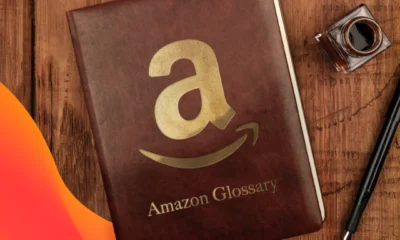



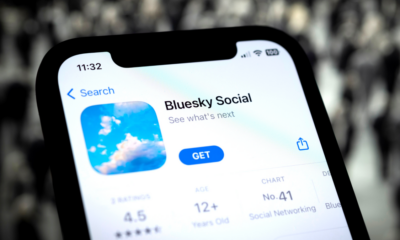







You must be logged in to post a comment Login